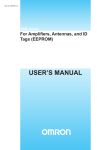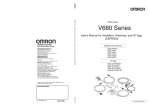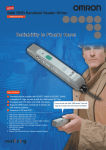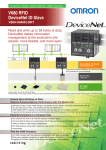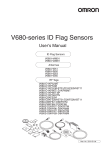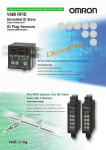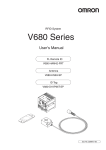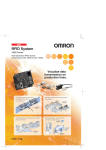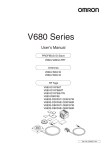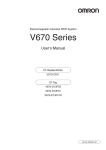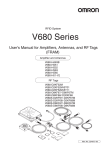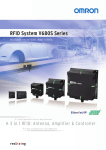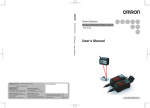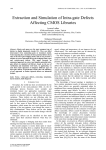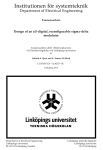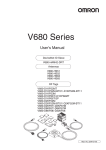Download V680 Series RFID User`s Manual for Amplifiers, Antennas
Transcript
RFID System V680 Series User's Manual for Amplifiers, Antennas, and ID Tags (FRAM) Amplifier and Antennas V680-HA63B V680-HS52 V680-HS63 V680-HS65 ID Tags V680-D2KF52M V680-D2KF67 V680-D2KF67M V680-D8KF68 V680-D32KF68 Cat. No.: Z248-E1-03A Introduction Thank you for purchasing a V680-series RFID System. This manual describes the functions, performance, and application methods needed for optimum use of the V680-series RFID System. Please observe the following items when using the RFID System. • Allow the RFID System to be installed and operated only by qualified specialist with a sufficient knowledge of electrical systems. • Read and understand this manual before attempting to use the RFID System and use the RFID System correctly. • Keep this manual in a safe and accessible location so that it is available for reference when required. READ AND UNDERSTAND THIS DOCUMENT Product Overview Section 2 Specifications and Performance Section 3 Communications Specifications Section 4 Installation Section 5 Chemical Resistance RFID System V680-HA63B V680-HS52 V680-HS63 V680-HS65 V680-D2KF52M V680-D2KF67 V680-D2KF67M V680-D8KF68 V680-D32KF68 Amplifier Antenna Antenna Antenna ID Tag ID Tag ID Tag ID Tag ID Tag User's Manual Section 1 Section 2 Section 3 Section 4 Section 5 Section 1 Introduction Introduction Introduction Introduction READ AND UNDERSTAND THIS DOCUMENT Please read and understand this document before using the products. Please consult your OMRON representative if you have any questions or comments. WARRANTY OMRON’s exclusive warranty is that the products are free from defects in materials and workmanship for a period of one year (or other period if specified) from date of sale by OMRON. OMRON MAKES NO WARRANTY OR REPRESENTATION, EXPRESS OR IMPLIED, REGARDING NON-INFRINGEMENT, MERCHANTABILITY, OR FITNESS FOR PARTICULAR PURPOSE OF THE PRODUCTS. ANY BUYER OR USER ACKNOWLEDGES THAT THE BUYER OR USER ALONE HAS DETERMINED THAT THE PRODUCTS WILL SUITABLY MEET THE REQUIREMENTS OF THEIR INTENDED USE. OMRON DISCLAIMS ALL OTHER WARRANTIES, EXPRESS OR IMPLIED. LIMITATIONS OF LIABILITY OMRON SHALL NOT BE RESPONSIBLE FOR SPECIAL, INDIRECT, OR CONSEQUENTIAL DAMAGES, LOSS OF PROFITS OR COMMERCIAL LOSS IN ANY WAY CONNECTED WITH THE PRODUCTS, WHETHER SUCH CLAIM IS BASED ON CONTRACT, WARRANTY, NEGLIGENCE, OR STRICT LIABILITY. In no event shall responsibility of OMRON for any act exceed the individual price of the product on which liability is asserted. IN NO EVENT SHALL OMRON BE RESPONSIBLE FOR WARRANTY, REPAIR, OR OTHER CLAIMS REGARDING THE PRODUCTS UNLESS OMRON’S ANALYSIS CONFIRMS THAT THE PRODUCTS WERE PROPERLY HANDLED, STORED, INSTALLED, AND MAINTAINED AND NOT SUBJECT TO CONTAMINATION, ABUSE, MISUSE, OR INAPPROPRIATE MODIFICATION OR REPAIR. SUITABILITY FOR USE THE PRODUCTS CONTAINED IN THIS DOCUMENT ARE NOT SAFETY RATED. THEY ARE NOT DESIGNED OR RATED FOR ENSURING SAFETY OF PERSONS, AND SHOULD NOT BE RELIED UPON AS A SAFETY COMPONENT OR PROTECTIVE DEVICE FOR SUCH PURPOSES. Please refer to separate catalogs for OMRON's safety rated products. OMRON shall not be responsible for conformity with any standards, codes, or regulations that apply to the combination of products in the customer’s application or use of the product. At the customer’s request, OMRON will provide applicable third party certification documents identifying ratings and limitations of use that apply to the products. This information by itself is not sufficient for a complete determination of the suitability of the products in combination with the end product, machine, system, or other application or use. The following are some examples of applications for which particular attention must be given. This is not intended to be an exhaustive list of all possible uses of the products, nor is it intended to imply that the uses listed may be suitable for the products: • Outdoor use, uses involving potential chemical contamination or electrical interference, or conditions or uses not described in this document. • Nuclear energy control systems, combustion systems, railroad systems, aviation systems, medical equipment, amusement machines, vehicles, safety equipment, and installations subject to separate industry or government regulations. • Systems, machines, and equipment that could present a risk to life or property. Please know and observe all prohibitions of use applicable to the products. NEVER USE THE PRODUCTS FOR AN APPLICATION INVOLVING SERIOUS RISK TO LIFE OR PROPERTY WITHOUT ENSURING THAT THE SYSTEM AS A WHOLE HAS BEEN DESIGNED TO ADDRESS THE RISKS, AND THAT THE OMRON PRODUCT IS PROPERLY RATED AND INSTALLED FOR THE INTENDED USE WITHIN THE OVERALL EQUIPMENT OR SYSTEM. PERFORMANCE DATA Performance data given in this document is provided as a guide for the user in determining suitability and does not constitute a warranty. It may represent the result of OMRON’s test conditions, and the users must correlate it to actual application requirements. Actual performance is subject to the OMRON Warranty and Limitations of Liability. CHANGE IN SPECIFICATIONS Product specifications and accessories may be changed at any time based on improvements and other reasons. It is our practice to change model numbers when published ratings or features are changed, or when significant construction changes are made. However, some specifications of the product may be changed without any notice. When in doubt, special model numbers may be assigned to fix or establish key specifications for your application on your request. Please consult with your OMRON representative at any time to confirm actual specifications of purchased products. DIMENSIONS AND WEIGHTS Dimensions and weights are nominal and are not to be used for manufacturing purposes, even when tolerances are shown. ERRORS AND OMISSIONS The information in this document has been carefully checked and is believed to be accurate; however, no responsibility is assumed for clerical, typographical, or proofreading errors, or omissions. PROGRAMMABLE PRODUCTS OMRON shall not be responsible for the user’s programming of a programmable product, or any consequence thereof. COPYRIGHT AND COPY PERMISSION This document shall not be copied for sales or promotions without permission. This document is protected by copyright and is intended solely for use in conjunction with the product. Please notify us before copying or reproducing this document in any manner, for any other purpose. If copying or transmitting this document to another, please copy or transmit it in its entirety. 2 RFID System User's Manual Introduction Introduction Safety Precautions Alert Symbols for Safe Use The following symbols are used in this manual to indicate precautions that must be observed to ensure safe use of the V680-HS63, V680-HS52, V680-HS65, V680-HA63B, V680-D2KF67, V680-D2KF67M, V680D2KF52M, V680-D8KF68, and V680-D32KF68. The precautions provided here contain important safety information. Be sure to observe these precautions. The following signal words are used in this manual. WARNING Indicates a potentially hazardous situation which, if not avoided, will result in minor or moderate injury, or may result in serious injury or death. Additionally, there may be significant property damage. Meanings of Alert Symbols Indicates general prohibitions for which there is no specific symbol. Warning WARNING These Products are not designed to be used either directly or indirectly in applications that detect human presence for the purpose of maintaining safety. Do not use these Products as a sensing means for protecting human lives. RFID System User's Manual 3 Introduction Introduction Regulations and Standards The Products conform to the following overseas regulations and standards. 1. The United States Amplifier This product complies with Part 15 Subpart C of the FCC Rules. FCC ID: E4E6CYSIDV6800306 V680-HA63B Antenna V680-HS52 V680-HS63 V680-HS65 FCC NOTICE This device complies with part 15 of the FCC Rules. Operation is subject to the following two conditions: (1) This device may not cause harmful interference. (2) This device must accept any interference received, including interference that may cause undesired operation. FCC WARNING Changes or modifications not expressly approved by the party responsible for compliance could void the user's authority to operate the equipment. Do not remove the ferrite core (TDK Type ZCAT1730-0730A) installed on the cables to suppress RF interference. 2. Europe Amplifier (Radio and Telecommunication Terminal Equipment Directive 1999/5/EC) Radio: EN 300 330-2V1.3.1 (04-2006) EN 300 330-1V1.5.1 (04-2006) EMC: EN 301 489-3V1.4.1 (08-2002) EN 301 489-1V1.6.1 (09-2005) Safety: EN 61010-1: 2001 (2nd Edition) 4 V680-HA63B Antenna V680-HS52 V680-HS63 V680-HS65 English Hereby, Omron, declares that the RFID System, V680-HS52 Series, V680-HS63 Series, V680-HS65 Series, and V680-HA63B Series are in compliance with the essential requirements and other relevant provisions of Directive 1999/5/EC. Finnish Omron vakuuttaa täten että RFID Säännös, V680-HS52 Series, V680-HS63 Series, V680-HS65 Series, V680-HA63B Series tyyppinen laite on direktiivin 1999/5/EY oleellisten vaatimusten ja sitä koskevien direktiivin muiden ehtojen mukainen. Dutch Hierbij verklaart Omron dat het toestel de RFID Systeem, V680-HS52 ´Serie, V680-HS63 ´Serie, V680-HS65 ´Serie, V680-HA63B ´Serie in overeenstemming is met de essentiële eisen en de andere relevante bepalingen van richtlijh 1999/5/EG. French Par la présente Omron déclare que la RFID Système, V680-HS52 Série, V680-HS63 Série, V680-HS65 Série, V680-HA63B Série sont conforme aux exigences essentielles et aux autres dispositions pertinentes de la directive 1999/5/CE. Swedish Härmed intygar Omron att den RFID System, V680-HS52 Serie, V680-HS63 Serie, V680-HS65 Serie V680-HA63B Serie stär l överensstämmelse med de väsentliga egenskapskrav och övriga relevanta bestämmelser som framgår av direktiv 1999/5/EG. Danish Undertegnede Omron erklærer herved, at følgende den RFID System, V680-HS52 Serie, V680-HS63 Serie, V680-HS65 Serie, 680-HA63B Serie overholder de væsentlige krav og øvrige relevante krav i direktiv 1999/5/EF. German Hiermit erklärt Omron, die RFID System, V680-HS52 Serie, V680-HS63 Serie, V680-HS65 Serie, V680-HA63B Serie in Übereinstimmung mit den grundlegenden Anforderungen und den anderen relevanten Vorschriften der Richtlinie 1999/5/EG befindet. (BMWi) Greek ME THN ΠAPOYSA Omron ∆HΛONEI RFID O’YO’ΓΗΜΑ, V680-HS52 O’EIPA, V680-HS63 O’EIPA, V680-HS65 O’EIPA V680-HA63B O’EIPA SYMMOPF ONETAI ΠPOS TIS OYSIO∆EIS AΠAITHSEIS KAI TIS ΛOIΠES SXETIKES ∆IATAΞEIS THS O∆HΓIAS 1999/5/EK. Italian Con la presente Omron dichiara che la RFID Sistema, V680-HS52Serie, V680-HS63 Serie, V680-HS65 Serie, V680-HA63B Serie sono conforme ai requisiti essenziali ed alle altre disposizioni pertinenti stabilite dalla direttiva 1999/5/CE. Spanish Por medio de la presente Omron declara que el RFID Sistema, V680-HS52 Serie, V680-HS63 Serie, V680-HS65 Serie, V680-HA63B Serie esta conforme a los requisitos esenciales y cualesquiera otras disposiciones aplicables o exigibles de la Directiva 1999/5/CE. Portuguese Omron declara que a RFID Sistema, V680-HS52 Série, V680-HS63 Série, V680-HS65 Série, V680-HA63B Série ser conforme com os tequisitos essenciais e outras disposições da Directiva 1999/5/CE. Romanian Prin prezenta, Omron declar c acest V680-HS52,V680-HS63,V680-HS65, V680-HA63B este conform cu cerin ele principale çi cu celelalte prevederi relevanate ale Directivei 1999/5/EC. RFID System User's Manual Introduction Introduction 3. Japan Amplifier Antenna Equipment using high frequencies: Inductive Reading/Writing Communications Equipment V680-HA63B V680-HS52 Conforming standards: Inductive Reading/Writing Communications Equipment; Standard: ARIB STD-T82 V680-HS63 EC-06020 V680-HS65 4. Canada Amplifier IC ID:850J-V68HA63B V680-HA63B Antenna V680-HS52 V680-HS63 V680-HS65 This device complies with RSS-Gen of IC Rules. Operation is subject to the following two conditions:(1) this device may not cause harmful interference, and (2) this device must accept any interference received, including interference that may cause undesired operation. 5. China Amplifier Antenna CMII ID:2007DJ0576 V680-HA63B V680-HS52-R CMII ID:2007DJ0574 V680-HA63B V680-HS52-W CMII ID:2007DJ0572 V680-HA63B V680-HS63-W CMII ID:2007DJ0570 V680-HA63B V680-HS63-R 6. Korea Amplifier OMR-V680-HA63B V680-HA63B Antenna V680-HS52-R V680-HS52-W V680-HS63-R V680-HS63-W RFID System User's Manual 5 Introduction Introduction 7. Taiwan Amplifier CCAB07LP1220T4 V680-HA63B Antenna V680-HS52 V680-HS63 8. Hong Kong Amplifier LP407042 V680-HA63B Antenna V680-HS52 V680-HS63 9. Singapore Amplifier S0293-07 V680-HA63B Antenna V680-HS52 V680-HS63 10.Malaysia Amplifier A011579 V680-HA63B Antenna V680-HS52 V680-HS63 If the product is used in Malaysia, a label must be attached on-site to the side of the V680-HA63B. Please consult your OMRON sales representative for details. 11.Philippine Amplifier ESD-0702971C V680-HA63B Antenna V680-HS52 V680-HS63 12.Mexico Amplifier COFETEL:RCPOMV607-329 V680-HA63B Antenna V680-HS52 V680-HS63 Este equipo opera a titulo secundario, consecuentemente, debe aceptar interferencias perjudiciales incluyendo equipos de la misma clase y puede no causar interferencias a sistemas operando a titulo primario. 13.Thailand The certification is unnecessary, so the product can be used. Changes or modifications not expressly approved by the party responsible for compliance could void the user's authority to operate the equipment. Do not remove the ferrite core (TDK Type ZCAT1730-0730A) installed on the cables to suppress RF interference. 6 RFID System User's Manual Introduction Introduction Precautions for Safe Use Be sure to observe the following precautions to ensure safe use of the Products. 1. Do not use the Products in environments with flammable, explosive, or corrosive gasses. 2. Do not attempt to disassemble, repair, or modify any Product. 3. Tighten mounting screws securely. 4. Because a cable has a locking mechanism, make sure that it has been locked before using the cable. 5. Do not allow water or pieces of wire to enter from openings in the case. Doing so may cause fire or 6. Turn OFF the Controller power supply before mounting or removing an Antenna or Amplifier. 7. If an error is detected in any Product, immediately stop operation and turn OFF the power supply. electric shock. Consult with an OMRON representative. 8. Dispose of the Products as industrial waste. 9. Observe all warnings and precautions given in the body of this manual. 10. Do not touch the product immediately after usage at high temperatures. Doing so may occasionally result in burning. RFID System User's Manual 7 Introduction Introduction Precautions for Correct Use Always observe the following precautions to prevent operation failures, malfunctions, and adverse effects on performance and equipment. 1. Installation Environment Do not use the Products in the following locations. • Locations exposed to corrosive gases, dust, metallic powder, or salts • Locations not within the specified operating temperature range • Locations subject to rapid changes in temperature or condensation • Locations not within the specified humidity range • Locations subject to direct vibration or shock outside the specified ranges • Locations subject to spray of water, oil, or chemicals 2. Installation The Products communicate with Tags using the 13.56-MHz frequency band. Some motors, inverters, and switching power supplies generate noise that can affect communications with the Tags and cause errors. If such devices are located near the Tags, always test operation in advance to confirm whether the system will be affected. • Observe the following precautions to minimize the effects of normal noise. (1) Ground all metal objects in the vicinity of the Products to 100 Ω or less. (2) Do not use the Products near high-voltage or high-current lines. • Do not use non-waterproof Products in an environment where mist is present. • Do not expose the Products to chemicals that adversely affect the Product materials. • When mounting the Products, tighten the screws to the following torques. V680-HS63: 1.2 N⋅m V680-HS52: 40 N⋅m V680-HS65: 1.2 N⋅m • Transmission will not be possible if the front and back panels are mistakenly reversed and the Unit is mounted to a metallic surface. V680-D2KF67M • The transmission distance will be reduced when the Unit is not mounted to a metallic surface. V680-D2KF67M • If multiple Antennas are mounted near each other, communications performance may decrease due to mutual interference. Refer to Installing Antennas on page 50 and check to make sure there is no mutual interference. • Depending on the operating environment, the case surface may become fogged, but basic performance will not be affected. 3. Storage Do not store the Products in the following locations. • Locations exposed to corrosive gases, dust, metallic powder, or salts • Locations not within the specified storage temperature range • Locations subject to rapid changes in temperature or condensation • Locations not within the specified storage humidity range • Locations subject to direct vibration or shock outside the specified ranges • Locations subject to spray of water, oil, or chemicals 8 RFID System User's Manual Introduction Introduction 4. Cleaning • Do not clean the Products with paint thinner or the equivalent. Paint thinner or the equivalent will dissolve the resin materials and case coating. 5. Combination of the Amplifier Use the V680-D2KF67, V680-D2KF67M, V680-D2KF52M, V680-D8KF68, and V680-D32KF68 ID Tags in combination with only the V680-HA63B Amplifier. Do not use these ID Tags together with the V680-HA63A Amplifier. RFID System User's Manual 9 Introduction Introduction Meanings of Symbols 10 Meanings of Symbols Indicates particularly important points related to a function, including precautions and application advice. Indicates page numbers containing relevant information. RFID System User's Manual Introduction Introduction Table of Contents Safety Precautions 3 Regulations and Standards 4 Precautions for Safe Use 7 Precautions for Correct Use 8 Meanings of Symbols 10 Table of Contents 11 Section 1 Product Overview 13 Features 14 Product Configuration 15 Section 2 Specifications and Performance 17 Antennas with Separate Amplifier 18 Amplifier 24 Tags 27 Section 3 Communications Specifications 35 Communications Distances 36 TAT and Communication Time (Reference) 44 Section 4 Installation 49 Installing Antennas 50 Mounting Amplifiers 55 Installing Tags 57 Section 5 Chemical Resistance 67 Chemical Resistance of the Antennas 68 Chemical Resistance of Tags 69 Degree of Protection 72 Revision History 74 RFID System User's Manual 11 Introduction Introduction 12 MEMO RFID System User's Manual Section 1 Section 1 Product Overview 14 Product Configuration 15 RFID System User's Manual Product Overview Features 13 Section 1 Product Overview Features The V680-series RFID System actively supports many different types of system, such as distributed-control Section 1 Features systems and many-product, small-lot production systems, with non-contact data communications using electromagnetic induction. Non-contact Data Communications The V680 Series uses electromagnetic induction to enable non-contact, bi-directional data communications between Antennas and Tags. FRAM Memory FRAM (non-volatile memory) is used for Tag memory. No battery is required, so there is no need to be concerned about battery service life. CRC Used for Transmission Error Detection A bi-directional 16-bit CRC (Cyclic Redundancy Check) has been added as the error detection method for wire transmissions between ID Controllers and Antennas, and for wireless transmissions between Antennas and Tags. This method maintains superior communications reliability even where problems such as noise occur. Memory Capacity of 2,000, 8K, or 32K Bytes Tags have a memory capacity of 2,000, 8K, or 32K bytes. In addition to the ID data required on-site, data such as model numbers and inspection information can be input. Long service life: 10 billion accesses The FRAM memory can be accessed up to 10 billion times (in units of single, 8-byte blocks) Superior Environmental Resistance and High Reliability Antennas and Tags now have greater environmental resistance and are not affected by vibration, oil, or water. 14 RFID System User's Manual Section 1 Product Overview Product Configuration A V680-series RFID System consists of an ID Controller, one or more Amplifiers, one or two Antennas, and Section 1 Product Configuration Tags. Select the models suitable for the application. Programmable Controller (PLC) Host device Personal computer RS-232C RS-422 V680-CA5D02-V2 ID Controller V680-CA5D01-V2 RS-485 Antennas with Separate Amplifier Amplifiers V680-HA63B V680-HS52 V680-D2KF67M V680-D2KF52M V680-HS65 V680-D8KF68/-D32KF68 Tags V680-D2KF67 V680-HS63 When embedding the V680-D2KF52M into a metal surface, use the V680-HS52 Antenna. Transmission will not be possible if the V680-HS63 Antenna is used. Use the V680-D2KF67, V680-D2KF67M, V680-D2KF52M, V680-D8KF68, and V680-D32KF68 ID Tags in combination with only the V680-HA63B Amplifier. Do not use these ID Tags together with the V680-HA63A Amplifier. RFID System User's Manual 15 Section 1 Product Overview MEMO Section 1 Product Configuration 16 RFID System User's Manual Section 2 Specifications and Performance Section 2 18 Amplifier 24 Tags 27 RFID System User's Manual Specifications and Performance Antennas with Separate Amplifier 17 Section 2 Specifications and Performance Antennas with Separate Amplifier V680-HS63 General Specifications Item Model V680-HS63-W (Standard cable, waterproof connector) V680-HS63-R (Flexible cable, non-waterproof connector) Section 2 Antennas with Separate Amplifier Ambient operating temperature −10 to 60°C (with no icing) Ambient storage temperature −25 to 75°C (with no icing) Ambient operating humidity 35% to 95% (with no condensation) Insulation resistance 20 MΩ min. (at 500 VDC) between cable terminals and case Dielectric strength 1,000 VAC, 50/60Hz for 1 min between cable terminals and case Degree of protection IP67 (IEC60529) In-house standard for antenna oil resistance (former JEM standard equivalent to IP67g) Note: The connector specifications are IP67 and IP65 (IEC 60529). Vibration resistance 10 to 500 Hz, 1.5-mm double amplitude, acceleration: 100 m/s2, 10 sweeps in each of 3 axis directions (up/down, left/right, and forward/backward) for 11 minutes each Shock resistance 500 m/s2, 3 times each in 6 directions (Total: 18 times) Dimensions 40 × 53 × 23 mm Material ABS resin case, epoxy resin filler Weight Approx. 850 g (with 12.5 m cable) Cable length Standard lengths of 2 and 12.5 m IP67 (IEC60529) In-house standard for antenna oil resistance (former JEM standard equivalent to IP67g) Note: The connectors are not waterproof. Dimensions • V680-HS63-W Antenna (Unit: mm) Ferrite core 16.5 dia. 6 30 53 16.5 dia. 40 28±0.1 5 27 5 Connector 14.5 dia. 37 50 Insulation cover Coaxial cable, 5.5 dia., standard length: 2 m 11 23 Operation indicator Note: Mounting Hole Dimensions Two, M4 or 4.5 dia. holes Coil center 18 RFID System User's Manual Case material ABS resin Fill resin Epoxy resin Cable PVC (gray) Section 2 Specifications and Performance • V680-HS63-R Antenna Ferrite core 6 30 53 Insulation cover 11 23 50 Coaxial cable, 5.3 dia., standard length: 2 m Operation indicator Note: Mounting Hole Dimensions Coil center 16.5 dia. 16.5 dia. 14.5 dia. 40 28±0.1 27 5 Two, M4 or 4.5 dia. holes Case material ABS resin Fill resin Epoxy resin Cable PVC (black) RFID System User's Manual Section 2 Antennas with Separate Amplifier 5 (39.5) (Unit: mm) Connector 19 Section 2 Specifications and Performance V680-HS52 General Specifications Item Model V680-HS52-W (Standard cable, waterproof connector) V680-HS52-R (Flexible cable, non-waterproof connector) Section 2 Antennas with Separate Amplifier Ambient operating temperature −10 to 60°C (with no icing) Ambient storage temperature −25 to 75°C (with no icing) Ambient operating humidity 35% to 95% (with no condensation) Insulation resistance 20 MΩ min. (at 500 VDC) between connector terminals and case Dielectric strength 1,000 VAC, 50/60 Hz for 1 min between connector terminals and case Degree of protection IP67 (IEC60529) In-house standard for antenna oil resistance (former JEM standard equivalent to IP67g) Note: The connector specifications are IP67 and IP65 (IEC 60529). Dielectric strength 10 to 500 Hz, 1.5-mm double amplitude, acceleration: 100 m/s2, 10 sweeps in each of 3 axis directions IP67 (IEC60529) In-house standard for antenna oil resistance (former JEM standard equivalent to IP67g) Note: The connectors are not waterproof. (up/down, left/right, and forward/backward) for 8 minutes each Shock resistance 500 m/s2, 3 times each in 6 directions (Total: 18 times) Dimensions M22 × 65 mm Material ABS resin, brass, and epoxy resin filler Weight Approx. 850 g (with 12.5 m cable) Cable length Standard lengths of 2 and 12.5 m Dimensions • V680-HS52-W 22.5 dia. Two toothed washers Two lock nuts Mounting Hole Dimensions M22 × 1 Ferrite core Operation indicator 37 16.5 dia. 30 7 30 47.6 50 57 65 20 RFID System User's Manual Connector 14.5 dia. 19.8 dia. 35 dia. 16.5 dia. Antenna 50 Insulation cover Coaxial cable, 5.5 dia., standard length: 2 m Case material Brass Communications surface ABS resin Fill resin Epoxy resin Cable PVC (gray) Section 2 Specifications and Performance • V680-HS52-R 22.5 dia. Two toothed washers Two lock nuts Mounting Hole Dimensions M22 × 1 16.5 dia. 14.5 dia. 19.8 dia. 30 Insulation cover Connector 16.5 dia. (39.5) 35 dia. Section 2 Antennas with Separate Amplifier Ferrite core Operation indicator Antenna 7 30 47.6 50 57 65 50 Coaxial cable, 5.3 dia., standard length: 2 m Insulation cover Case material Brass Communications surface ABS resin Fill resin Epoxy resin Cable PVC (black) RFID System User's Manual 21 Section 2 Specifications and Performance V680-HS65 General Specifications Item Model V680-HS65-W (Standard cable, waterproof connector) V680-HS65-R (Flexible cable, non-waterproof connector) Section 2 Antennas with Separate Amplifier Ambient operating temperature −25 to 70°C (with no icing) Ambient storage temperature −40 to 85°C (with no icing) Ambient operating humidity 35% to 95% (with no condensation) Insulation resistance 20 MΩ min. (at 500 VDC) between connector terminals and case Dielectric strength 1,000 VAC, 50/60 Hz for 1 min between connector terminals and case Degree of protection IP67 (IEC60529) In-house standard for antenna oil resistance (former JEM standard equivalent to IP67g) Note: The connector specifications are IP67 and IP65 (IEC 60529). Dielectric strength 10 to 500 Hz, 1.5-mm double amplitude, acceleration: 100 m/s2, 10 sweeps in each of 3 axis directions IP67 (IEC60529) In-house standard for antenna oil resistance (former JEM standard equivalent to IP67g) Note: The connectors are not waterproof. (up/down, left/right, and forward/backward) for 11 minutes each Shock resistance 500 m/s2, 3 times each in 6 directions (Total: 18 times) Dimensions 100 × 100 × 30 mm Material ABS resin case, epoxy resin filler Weight Approx. 1100 g (with 12.5 m cable) Cable length Standard lengths of 2 and 12.5 m Dimensions • V680-HS65-W 5 4-4.5 dia. (Mounting holes) 50 5 Operation indicator (Unit: mm) 100 90±0.2 Ferrite core 50 30 10 20 30 User's Manual 50 10 14 RFID System 16.5 dia. 16.5 dia. 100 90±0.2 14.5 dia. 25 Bushing 22 Connector 37 Coaxial cable, 5.5 dia., standard length: 2 m Insulation cover 11 Case material ABS resin Fill resin Epoxy resin Cable PVC (gray) Section 2 Specifications and Performance V680-HS65-R 5 4-4.5 dia. (Mounting holes) 50 5 Operation indicator (Unit: mm) 100 90±0.2 Ferrite core Connector 50 16.5 dia. 14.5 dia. 16.5 dia. 100 90±0.2 Bushing 30 10 50 10 20 30 14 Coaxial cable, 5.3 dia., standard length: 2 m Insulation cover 11 Case material ABS resin Fill resin Epoxy resin Cable PVC (black) RFID System User's Manual Section 2 Antennas with Separate Amplifier (39.5) 25 23 Section 2 Specifications and Performance Amplifier V680-HA63B General Specifications Item Model V680-HA63B Section 2 Amplifier Ambient operating temperature −10 to 55°C (with no icing) Ambient storage temperature −25 to 65°C (with no icing) Ambient operating humidity 35% to 85% (with no condensation) Insulation resistance 20 MΩ min. (at 500 VDC) between cable terminals and case Dielectric strength 1,000 VAC, 50/60 Hz for 1 minute between cable terminals and case. Degree of protection IP67, IP65 (IEC 60529) Note: Not including connector at Controller end. (When V680-HS63-W or V680-HS52-W is connected) Dielectric strength 10 to 500 Hz, 1.5-mm double amplitude, acceleration:100 m/s2, 10 sweeps in each of 3 axis directions IP40 (IEC 60529) (When V680-HS63-R or V680-HS52-R is connected) (up/down, left/right, and forward/backward) for 11 minutes each Shock resistance 500 m/s2, 3 times each in 6 directions (Total: 18 times) Dimensions 25 × 40 × 65 mm (Not including protrusions.) Materials PC Weight Approx. 650 g (with 10 m cable) Cable length Standard lengths of 5 and 10 m Note: The maximum total cable extension is 50 m (including the Amplifier cable). A maximum of two extension cables can be connected. Dimensions 65 18 24 25 40 25 9.5 dia. Connector RFID System User's Manual 36 35.6 3.5 Connector 15 25 51 15 dia. 13.7 12.8 dia. Operation indicator Round, vinyl-insulated cable (5.8 dia.), standard length: 5 m, (41/0.16 dia) 2 conductors, (17/0.08 dia.) 8 conductors Case material PC resin Cable PVC Section 2 Specifications and Performance Nomenclature Antenna connection port Operation indicators Section 2 Amplifier RUN COMM NORM ERR LV6/7D LV5/7A LV4/76 LV3/72 LV2/71 LV1/70 Controller connector Antenna Connection Port The Antenna connection port is connected a V680-series Antenna. Controller Connector The Controller connector is connected to Antenna connection port on the Controller. Operation Indicators (LEDs) Name RUN Color Meaning Green Lit when the power is ON. COMM Yellow Lit when a command is being sent. NORM Green Lit when communications with a Tag are normal in Normal Communications Mode. ERR Red Lit when an error occurs in communications with a Tag in Normal Communications Mode. LV6/7D Maintenance Mode: Lit at distance or speed level 6. Yellow Normal Communications Mode: Lit when a write protection error occurs. LV5/7A Yellow Maintenance Mode: Lit at distance or speed level 5 or higher. Normal Communications Mode: Lit when an address error occurs. LV4/76 Yellow Maintenance Mode: Lit at distance or speed level 4 or higher. Normal Communications Mode: Lit when a Tag memory error occurs. LV3/72 Yellow Maintenance Mode: Lit at distance or speed level 3 or higher. Normal Communications Mode: Lit when a no Tag error occurs. LV2/71 Yellow Maintenance Mode: Lit at distance or speed level 2 or higher. Normal Communications Mode: Lit when a verification error occurs. LV1/70 Yellow Maintenance Mode: Lit at distance or speed level 1 or higher. Normal Communications Mode: Lit when a Tag communications error occurs. The distance level will vary greatly depending on the surrounding environment. The setting position will serve as a guide, but use RUN mode to conduct a sufficient number of tests in the actual operating environment. Values of distance level 4 or above may not be displayed, but this will not affect the RUN mode performance and does not indicate a malfunction. RFID System User's Manual 25 Section 2 Specifications and Performance Cables Specifications Item Model V700-A43/V700-A44 Number of conductors 10 Insulation resistance 5 M Ω min. (at 500 VDC) between terminals and sheath Dielectric strength 500 VAC, 1 min Item Model Length (L1) Weight V700-A43 V700-A44 Approx.10m Approx. 20 m Approx. 700 g Approx.1,350 g L1±100 49 6 dia. 15 dia. 51 15.5 dia. Section 2 Amplifier Dimensions Connector (Amplifier end) Connector (Controller end)) Connection label (Unit: mm) Casing material 26 RFID System User's Manual PVC Section 2 Specifications and Performance Tags Specifications and Dimensions V680-D2KF52M • General Specifications Model Memory capacity V680-D2KF52M Section 2 Tags Item 2,000 bytes (user area) Memory type FRAM Data backup time 10 years after writing (55°C or less) Memory longevity 10 billion times per block. Access frequency (See note) : 10 billion times Ambient operating temperature −25 to 85°C (with no icing) Ambient storage temperature −40 to 85°C (with no icing) Ambient operating humidity 35% to 85% Degree of protection IP67 (IEC 60529) Vibration resistance 10 to 2,000 Hz, 1.5-mm double amplitude, acceleration: 150 m/s2, 10 sweeps each in X, Y, and Z Shock resistance 500 m/s2, 3 times each in X, Y, and Z directions (Total: 18 times) directions for 15 minutes each Dimensions 8 dia. × 5 mm Materials Case: PPS resin, Fill resin: Epoxy resin Weight Approx. 0.5 g Metal countermeasures Yes Note: The total communication frequency of the Read or Write is called an access frequency. • Dimensions R0.2 0 8 −0.1 dia. 0 5 −0.1 (Unit: mm) Case material PPS resin Fill resin Epoxy resin When embedding the V680-D2KF52M into a metal surface, use the V680-HS52 Antenna. Transmission will not be possible if the V680-HS63 Antenna is used. The side with the markings is the communications surface. Mount the Tag with this side facing the Antenna. RFID System User's Manual 27 Section 2 Specifications and Performance V680-D2KF67/67M • General Specifications Item Model V680-D2KF67 V680-D2KF67M Section 2 Tags Memory capacity 2,000 bytes (user area) Memory type FRAM Data backup time 10 years after writing (55°C or less) Memory longevity 10 billion times per block. Access frequency (See note) : 10 billion times Ambient operating temperature −25 to 85°C (with no icing) Ambient storage temperature −40 to 85°C (with no icing) Ambient operating humidity 35% to 85% Degree of protection IP67 (IEC 60529) Vibration resistance 10 to 2,000 Hz, 1.5-mm double amplitude, acceleration: 150 m/s2,10 sweeps each in X, Y, and Z directions for 15 minutes each Shock resistance 500 m/s2, 3 times each in X, Y, and Z directions (Total: 18 times) Dimensions 40 × 40 × 4.5 mm Materials Case: ABS resin Weight Approx. 6.5 g Approx. 7 g Metal countermeasures None Yes Note: The total communication frequency of the Read or Write is called an access frequency. The V680-D2KF67M is designed to be mounted directly to metal. The V680-D2KF67 and V680D2KF67M markings are shown in the following diagrams. V680-D2KF67M V680-D2KF67 METAL V680-D2KF67M V680-D2KF67 The side with the markings is the communications surface. Mount the Tag with this side facing the Antenna. 28 RFID System User's Manual Section 2 Specifications and Performance • Dimensions V680-D2KF67/67M 8 0.2 8 (Unit: mm) 5.2 13.2 4.5 Two, 3.5-dia. mounting holes 5.2 13.2 Two, M3 2 8 16 40+0.1 −0.5 Mounting reference surface 16 Section 2 Tags Mounting Hole Dimensions 16 32±0.2 8 16 32±0.2 40+0.1 −0.5 Case material ABS resin Fill resin Epoxy resin RFID System User's Manual 29 Section 2 Specifications and Performance V680-D8KF68/-D32KF68 • General Specifications Item Model V680-D8K68 V680-D32KF68 Section 2 Tags Memory capacity 8,192 bytes (user area) Memory type FRAM 32,744 bytes (user area) Data backup time 10 years after writing (70°C max.), 6 years after writing (85°C max.) Memory longevity 10 billion times per block (85°C or less). Access frequency (See note): 10 billion times −20 to 85°C (with no icing) Ambient operating temperature Ambient storage temperature −40 to 85°C (with no icing) Ambient operating humidity 35% to 85% Degree of protection IP67 (IEC 60529) In-house standard for oil resistance (former JEM standard equivalent to IP67g) Vibration resistance 10 to 500 Hz, 1.5-mm double amplitude, acceleration: 100 m/s2, 10 sweeps each in X, Y, and Z directions for 11 minutes each Shock resistance 500 m/s2, 3 times each in X, Y, and Z directions (Total: 18 times) Dimensions 86 × 54 × 10 mm Materials Case: PBT resin Fill resin: Epoxy resin Weight Approx. 50 g Metal countermeasures None Note: The total communication frequency of the Read or Write is called an access frequency. • Dimensions V680-D2KF68/68M (Unit: mm) Two, 4.5-dia. mounting holes 10 44 54 44±0.2 10 Mounting Hole Dimensions Two, M4 76 10 5 76±0.2 86 Case material PBT resin Fill resin Epoxy resin The side with the markings is the communications surface. Mount the Tag with this side facing the Antenna. 30 RFID System User's Manual Section 2 Specifications and Performance V680-A81 (Unit: mm) Two, 4.5 dia. mouting holes 44 Two, M4 76 10 76±0.2 86 Case material PBT resin Fill resin Epoxy resin RFID System User's Manual Section 2 Tags 44±0.2 54 Mounting Hole Dimensions 31 Section 2 Specifications and Performance Memory Map V680-D2KF52/-D2KF67/-D2KF67M Data Address Section 2 Tags 0000 0001 H 0002 H 0003 H H User area FRAM is used as memory in the Tags. 07CE H The memory capacity available to the user is 07CF H 2,000 bytes, including 0000H to 0003H (the 1 byte Write Protection Setting Area). V680-D8KF68 Data Address 0000 0001 H 0002 H 0003 H H User area FRAM is used as memory in the Tags. 1FFE H The memory capacity available to the user is 1FFF H 8,192 bytes, including 0000H to 0003H (the 1 byte Write Protection Setting Area). V680-D32KF68 Data Address 0000 0001 H 0002 H 0003 H H User area FRAM is used as memory in the Tags. 7FE6 H 7FE7 H The memory capacity available to the user is 32,744 bytes, including 0000H to 0003H (the 1 byte The access to the memory is executed at every block 1 block is 8 bytes (8 addresses). 32 RFID System User's Manual Write Protection Setting Area). Section 2 Specifications and Performance Write Protection Function The write protection function prevents important data, such as product information, stored in memory in a Tag from being inadvertently overwritten. After important data has been written to memory, it can be write-protected using the following method. The write protect function setting can be switched with switches 4 to 7 (Write Protect Function Setting) of the V680CA5D@@-V2 Controller. Write protection is set in Tag addresses 0000H to 0003H. The setting for the most significant bit of address 0000H specifies whether or not write protection is enabled. Address Bit 7 6 YES/ NO 0000H 5 4 3 2 1 Section 2 Tags Setting the Write Protection Function 0 Upper two digits of start address (00 to 7F) 0001H Lower two digits of start address (00to FF) 0002H Upper two digits of end address (00 to FF) 0003H Lower two digits of end address (00 to FF) • Write-protect Bit (Most significant bit of address 0000H) 1: Write-protected (Yes) 0: Not write-protected (No) • Write Protection Setting Area Start address: 0000H to 7FFFH End address: 0000H to FFFFH Write Protection Setting Examples • Settings to write-protect addresses 0008H through 03E7H: Address Bit 0000H 7 6 1 0 5 4 3 2 0 0 0 0 8 0001H 0 0 0 0 0 0 1 0 0 0 0 0 1 1 0 0 0 0 1 1 1 1 1 0 0 0 0 0 0 0 0 0 8 0 0003H 0 0 0 0002H 1 3 1 0 0 1 E 7 • Settings to not write-protect any addresses: Address 0000H 0001H 0002H 0003H Bit 7 6 0 0 5 4 3 2 0 0 0 0 0 0 0 0 0 0 0 0 0 0 0 0 0 0 0 0 0 0 0 0 0 0 0 0 0 0 The write protect function is a function of the V680-CA5D@@-V2 Controller. This function is not supported by reader/ writer units of other brands. RFID System User's Manual 33 Section 2 Specifications and Performance MEMO Section 2 Tags 34 RFID System User's Manual Section 3 Communications Specifications 36 TAT and Communication Time (Reference) 45 Section 3 Communications Distances Communications Specifications RFID System User's Manual 35 Section 3 Communications Specifications Communications Distances V680-D2KF52M Communications Distance Specifications (Certified Performance) Antenna Amplifier V680-HA63B ID Tag V680-HS52 V680-D2KF52M V680-HS52 V680-D2KF52M embedded in metal (steel) Section 3 Communications Distances V680-HS63 V680-D2KF52M Communications distance Read 0 to 8.0 mm (Axis offset: ±2) Write 0 to 8.0 mm (Axis offset: ±2) Read 0 to 3.0 mm (Axis offset: ±2) Write 0 to 3.0 mm (Axis offset: ±2) Read 0 to 9.5 mm (Axis offset: ±2) Write 0 to 9.5 mm (Axis offset: ±2) When embedding the V680-D2KF52M into a metal surface, use the V680-HS52 Antenna. Transmission will not be possible if the V680-HS63 Antenna is used. • Measurement Conditions V680-D2KF52M Metal V680-HS52 V680-HS52 V680-D2KF52M Non-metallic material Non-metallic material Non-metallic material (Examples: Resin, plastic, wood, etc.) V680-HS63 Non-metallic material (Examples: Resin, plastic, wood, etc.) V680-D2KF52M Non-metallic material 36 RFID System User's Manual Section 3 Communications Specifications Communications Area (Reference) V680-HS52 & V680-D2KF52M V680-HS52 & V680-D2KF52M Embedded in Metal (Steel) Read/Write Read/Write 30 30 Y 25 20 X Y Axis Y Axis 20 15 5 5 -15 -10 -5 0 5 10 X Axis 15 20 25 (Unit: mm) 0 -25 -20 -15 -10 -5 0 X Axis 5 10 15 20 Section 3 Communications Distances 10 -20 X 15 10 0 -25 Y 25 25 (Unit: mm) V680-HS63 & V680-D2KF52M Read/Write 30 Y 25 Y Axis 20 X 15 10 5 0 -25 -20 -15 -10 -5 0 X Axis 5 10 15 20 25 (Unit: mm) RFID System User's Manual 37 Section 3 Communications Specifications V680-D2KF67 Communications Distance Specifications (Certified Performance) Amplifier V680-HA63B Antenna ID Tag V680-HS52 V680-D2KF67 V680-HS63 V680-D2KF67 V680-HS65 V680-D2KF67 Communications distance 0 to 17.0 mm (Axis offset: ±2) Write 0 to 17.0 mm (Axis offset: ±2) Read 7.0 to 30.0 mm (Axis offset: ±10) Write 7.0 to 30.0 mm (Axis offset: ±10) Read 0 to 42.0 mm (Axis offset: ±10) Write 0 to 42.0 mm (Axis offset: ±10) Section 3 Communications Distances • Measurement Conditions V680-D2KF67 V680-HS63 Non-metallic material (Examples: Resin, plastic, wood, etc.) V680-HS52 Non-metallic material Non-metallic material (Examples: Resin, plastic, wood, etc.) V680-HS65 V680-D2KF67 Non-metallic material Non-metallic material (Examples: Resin, plastic, wood, etc.) V680-D2KF67 Metal 38 Read RFID System User's Manual Section 3 Communications Specifications Communications Area (Reference) V680-HS52 & V680-D2KF67 V680-HS63 & V680-D2KF67 Read/Write Read/Write 70 70 Y 60 50 50 X 40 Y Axis Y Axis Y 60 30 30 20 10 10 0 -70 -60 -50 -40 -30 -20 -10 0 10 20 30 40 50 60 70 X Axis 0 10 20 30 40 50 60 70 X Axis (Unit: mm) Section 3 Communications Distances 20 0 -70 -60 -50 -40 -30 -20 -10 X 40 (Unit: mm) V680-HS65 & V680-D2KF67 Read/Write Y 100 80 Y Axis X 60 40 20 0 -100 -80 -60 -40 -20 0 X Axis 20 40 60 80 100 (Unit: mm) RFID System User's Manual 39 Section 3 Communications Specifications V680-D2KF67M Communications Distance Specifications (Certified Performance) Amplifier Antenna V680-HA63B ID Tag V680-HS52 V680-D2KF67M with metal on back surface (steel) Read 0 to 16.0 mm (Axis offset: ±2) Write 0 to 16.0 mm (Axis offset: ±2) V680-HS63 V680-D2KF67M with metal on back surface (steel) Read 6.0 to 25.0 mm (Axis offset: ±10) Write 6.0 to 25.0 mm (Axis offset: ±10) V680-HS65 V680-D2KF67M with metal on back surface (steel) Read 0 to 25.0 mm (Axis offset: ±10) Write 0 to 25.0 mm (Axis offset: ±10) Section 3 Communications Distances • Measurement Conditions V680-D2KF67M V680-HS63 Metal V680-HS52 V680-D2KF67M Non-metallic material Metal Non-metallic material V680-HS65 Metal V680-D2KF67M Metal 40 Communications Distance RFID System User's Manual Section 3 Communications Specifications Communications Area (Reference) V680-HS52 & V680-D2KF67M with Metal on Back Surface (Steel) Read/Write V680-HS63 & V680-D2KF67M with Metal on Back Surface (Steel) Read/Write 70 70 Y 60 50 50 X 40 Y Axis Y Axis Y 60 30 30 20 10 10 0 10 20 30 40 50 60 70 X Axis (Unit: mm) 0 -70 -60 -50 -40 -30 -20 -10 0 10 20 30 40 50 60 70 X Axis (Unit: mm) V680-HS65& V680-D2KF67M with Metal on Back Surface (Steel) Read/Write 100 Y Y Axis 80 X 60 40 Section 3 Communications Distances 20 0 -70 -60 -50 -40 -30 -20 -10 X 40 20 0 -100 -80 -60 -40 -20 0 X Axis 20 40 60 80 100 (Unit: mm) RFID System User's Manual 41 Section 3 Communications Specifications V680-D8KF68/-D32KF68 Communications Distance Specifications (Certified Performance) Amplifier Antenna ID Tag V680-D8KF68 V680-D8KF68 (with ATTACHMENT, V680-A81) with metal on back surface (steel) V680-HS63 V680-D32KF68 Section 3 Communications Distances V680-D32KF68 (with ATTACHMENT, V680-A81) with metal on back surface (steel) V680-HA63B V680-D8KF68 V680-D8KF68 (with ATTACHMENT, V680-A81) with metal on back surface (steel) V680-HS65 V680-D32KF68 V680-D32KF68 (with ATTACHMENT, V680-A81) with metal on back surface (steel) Communications Distance Read 0 to 45.0 mm (Axis offset: ±10) Write 0 to 45.0 mm (Axis offset: ±10) Read 0 to 35.0 mm (Axis offset: ±10) Write 0 to 35.0 mm (Axis offset: ±10) Read 0 to 45.0 mm (Axis offset: ±10) Write 0 to 45.0 mm (Axis offset: ±10) Read 0 to 35.0 mm (Axis offset: ±10) Write 0 to 35.0 mm (Axis offset: ±10) Read 0 to 75.0 mm (Axis offset: ±10) Write 0 to 75.0 mm (Axis offset: ±10) Read 0 to 55.0 mm (Axis offset: ±10) Write 0 to 55.0 mm (Axis offset: ±10) Read 0 to 75.0 mm (Axis offset: ±10) Write 0 to 75.0 mm (Axis offset: ±10) Read 0 to 55.0 mm (Axis offset: ±10) Write 0 to 55.0 mm (Axis offset: ±10) • Measurement Conditions V680-D8KF68/-D32KF68 V680-D8KF68/-D32KF68 V680-A81 (ATTACHMENT) V680-HS63 V680-HS63 Non-metallic material (Examples: Resin, plastic, wood, etc.) Metal Metal Metal V680-HS65 V680-HS65 V680-A81 (ATTACHMENT) V680-D8KF68 V680-D32KF68 V680-D8KF68 V680-D32KF68 Metal 42 RFID System User's Manual Non-metallic material (Examples: Resin, plastic, wood, etc.) Metal Metal Section 3 Communications Specifications Communications Area (Reference) V680-HS63 and V680-D8KF68/ V680-D32KF68 (Vertical-facing ID Tag) Read/Write V680-HS63 and V680-D8KF68/ V680-D32KF68 (Horizontal-facing ID Tag) Read/Write 80 80 Y 70 60 60 X X 50 Y Axis 50 Y Axis Y 70 40 30 40 30 20 10 10 0 -80 -70 -60 -50 -40 -30 -20 -10 0 10 20 30 40 50 60 70 80 0 -80 -70 -60 -50 -40 -30 -20 -10 0 10 20 30 40 50 60 70 80 X Axis X Axis (Unit: mm) (Unit: mm) V680-HS63 and V680-D8KF68/ V680-HS63 and V680-D8KF68/ V680-D32KF68 (with ATTACHMENT, V680-A81) V680-D32KF68 (with ATTACHMENT, V680-A81) (Metal on back: Steel) (Metal on back: Steel) Read/Write Read/Write (Horizontal-facing ID Tag) (Vertical-facing ID Tag) 80 80 Y 70 60 60 X X 50 Y Axis 50 Y Axis Y 70 40 30 40 30 20 20 10 10 0 -80 -70 -60 -50 -40 -30 -20 -10 0 10 20 30 40 50 60 70 80 0 -80 -70 -60 -50 -40 -30 -20 -10 0 10 20 30 40 50 60 70 80 X Axis X Axis (Unit: mm) (Unit: mm) V680-HS65 and V680-D8KF68/ V680-D32KF68 (Horizontal-facing ID Tag) Read/Write V680-HS65 and V680-D8KF68/ V680-D32KF68 (Vertical-facing ID Tag) Read/Write 120 120 Y 100 Y 100 80 X 60 Y Axis 80 Y Axis Section 3 Communications Distances 20 40 40 20 20 0 X 60 0 -120 -100 -80 -60 -40 -20 0 20 40 60 80 100 120 X Axis -120 -100 -80 -60 -40 -20 0 20 40 60 80 100 120 X Axis (Unit: mm) (Unit: mm) V680-HS65 and V680-D8KF68/ V680-HS65 and V680-D8KF68/ V680-D32KF68 (with ATTACHMENT, V680-A81) V680-D32KF68 (with ATTACHMENT, V680-A81) (Metal on back: Steel) (Metal on back: Steel) Read/Write (Horizontal-facing ID Tag) Read/Write (Vertical-facing ID Tag) 120 120 Y 100 80 X 60 Y Axis 80 Y Axis Y 100 40 40 20 20 0 X 60 0 -120 -100 -80 -60 -40 -20 0 X Axis 20 40 60 80 100 120 (Unit: mm) -120 -100 -80 -60 -40 -20 0 X Axis 20 40 60 80 100 120 (Unit: mm) RFID System User's Manual 43 Section 3 Communications Specifications TAT and Communication Time (Reference) TAT and Communications Time (Reference) Communications Time V680-HA63B, V680-HS@@, V680-D2KF@@ Command Communications time N: No. of bytes processed Normal mode Read T = 1.2 N + 30 Write (with verification) T = 2.4 N + 49 Write (without verification) T = 1.2 N + 49 Read T = 0.9 N + 27 Write (with verification) T = 1.7 N + 49 Write (without verification) T = 0.9 N + 41 High-speed mode (See note.) Note: When using multi-access or FIFO communications options, normal-mode communications speed will be used regardless of the high-speed mode setting. 5,000 4,500 4,000 Write (with verification) 3,500 Write (without verification) 3,000 2,500 2,000 Communications speed: high-speed mode Communications time (ms) Communications speed: Normal mode Communications time (ms) Section 3 TAT and Communication Time (Reference) Communications speed setting 3,500 3,500 3,000 Write (with verification) 2,500 Write (without verification) 2,000 1,500 Reading 1,500 Reading 1,000 1,000 500 500 0 500 1,000 1,500 2,000 0 2,500 500 1,000 No. of bytes (byte) 2,000 1,500 2,500 No. of bytes (byte) V680-HA63B, V680-HS@@, V680-D8KF@@, V680-D32KF@@ Communications speed setting Normal mode High-speed mode (See note.) Command Communications time N: No. of bytes processed Read T = 1.3 N + 30 Write (with verification) T = 1.6 N + 59 Write (without verification) T = 1.3 N + 50 Read T = 0.8 N + 25 Write (with verification) T = 1.1 N + 41 Write (without verification) T = 0.9 N + 40 Note: When using multi-access or FIFO communications options, normal-mode communications speed will be used regardless of the high-speed mode setting. 3,500 3,000 Write (without verification) Write (with verification) 2,500 2,000 Reading 1,500 Communications speed: high-speed mode Communications time (ms) Communications time (ms) Communications speed: Normal mode 2,500 2,000 Write (with verification) Write (without verification) 1,500 1,000 Reading 1,000 500 500 0 500 1,000 1,500 2,000 2,500 No. of bytes (byte) 44 RFID System User's Manual 0 200 400 600 800 1,000 1,200 No. of bytes (byte) Section 3 Communications Specifications TAT (Turn Around Time) “TAT” is the total time from the start of command transmission by the host device (e.g., a personal computer) until a response is received by the host device. TAT = Command transmission time + Tag communications time + Response reception time The time required to send a command from the host device to the ID Controller. The command transmission time varies depending on the baud rate and the communications format. Tag communications time: The processing time for communications between the Antenna and Tag. Response reception time: The time required to return a response from the ID Controller to the host device. The response reception time varies depending on the baud rate and the communications format. • Normal Commands (Command) RDA1- - - - *CR Tag communications time RD001234- - - - *CR Response TAT • EXPANSION READ Command (Command) Host device XRA1- - - - *CR ID Controller Command transmission time (Delimiter) CR (Delimiter) CR Frame 1 Tag (Response 1) communications time Frame 2 (Response 2) (Delimiter) CR (Delimiter) CR Frame n (Response n) Frame n-1 (Response n-1) Response reception time TAT • EXPANSION WRITE Command (Command) Host device XWA1- - - - *CR ID Controller - - - - -CR CR (Response 1) Section 3 TAT and Communication Time (Reference) Command transmission time: - - - - -CR CR (Response 2) CR (Response n-1) Command transmission time XW00*CR (Response n) Tag communications Response reception time time TAT RFID System User's Manual 45 Section 3 Communications Specifications V680-HA63B, V680-HS@@, V680-D2KF@@ Conditions Read Communications speed Normal mode Section 3 TAT and Communication Time (Reference) Write With verification Communications speed Normal mode Write Without verification Communications speed Normal mode Read (See note. 1) Communications speed High-speed mode Write (See note 1.) With verification Communications speed High-speed mode Write (See note 1.) Without verification Communications speed High-speed mode No. of bytes processed (byte) 100 9,600 bps (ms) 19,200 bps (ms) 291 38,400 bps (ms) 220 115,200 bps (ms) 185 162 256 658 498 417 363 512 1,259 951 798 695 1,000 2,400 1,820 1,520 1,330 2,000 4,760 3,590 3,020 2,620 100 430 359 324 301 256 984 824 743 689 512 1,892 1,584 1,431 1,328 1,000 3,619 3,039 2,739 2,549 2,000 7,139 4,849 5,439 5,039 100 310 239 204 181 256 677 517 436 382 512 1,278 970 817 714 1,000 2,419 1,839 1,539 1,349 2,000 4,779 2,449 3,039 2,639 100 261 190 155 132 256 581 421 340 286 512 1,105 797 644 541 1,000 2,100 1,520 1,220 1,030 2,000 4,160 1,830 2,420 2,020 100 360 289 254 231 256 805 645 564 510 512 1,534 1,226 1,073 970 1,000 2,919 2,339 2,039 1,849 2,000 5,779 3,449 4,039 3,639 100 272 201 166 143 256 592 432 351 297 512 1,116 808 655 552 1,000 2,111 1,531 1,231 1,041 2,000 4,171 1,841 2,431 2,031 Note 1. When using multi-access or FIFO communications options, normal-mode communications speed will be used regardless of the high-speed mode setting. 2. TAT data is for a V680-CA5D01/02-V2 ID Controller with the following communications settings: 8-bit data length, 1 stop bit, and odd parity. Data was sent continuously without breaks between characters. 3. The number of bytes for TAT data is when the code designation is set to ASCII. 46 RFID System User's Manual Section 3 Communications Specifications V680-HA63B, V680-HS@@, V680-D8KF@@, V680-D32KF@@ Conditions Read Communications speed Normal mode Write Without verification Communications speed Normal mode Read (See note 1.) Communications speed High-speed mode Write (See note 1.) With verification Communications speed High-speed mode Write (See note 1.) Without verification Communications speed High-speed mode 9,600 bps (ms) 19,200 bps (ms) 38,400 bps (ms) 115,200 bps (ms) 100 301 230 195 172 256 683 523 442 388 512 1,310 1,002 849 746 1,000 2,500 1,920 1,620 1,430 2,000 4,960 2,630 3,220 2,820 100 360 289 254 231 256 789 629 548 494 512 1,493 1,185 1,032 929 1,000 2,829 2,249 1,949 1,759 2,000 5,589 3,259 3,849 3,449 100 321 250 215 192 256 703 543 462 408 512 1,330 1,022 889 766 1,000 2,520 1,940 1,640 1,450 2,000 4,980 2,650 3,240 2,840 100 246 175 140 117 256 550 390 309 255 512 1,049 741 588 485 1,000 1,995 1,415 1,115 925 2,000 3,955 1,625 2,215 1,815 100 292 221 186 163 256 643 483 402 348 512 1,219 911 758 655 1,000 2,311 1,731 1,431 1,241 2,000 4,571 2,241 2,831 2,431 100 271 200 165 142 256 591 431 350 296 512 1,115 807 654 551 1,000 2,110 1,530 1,230 1,040 2,000 4,170 1,840 2,430 2,030 Section 3 TAT and Communication Time (Reference) Write With verification Communications speed Normal mode No. of bytes processed (byte) Note 1. When using multi-access or FIFO communications options, normal-mode communications speed will be used regardless of the high-speed mode setting. 2. TAT data is for a V680-CA5D01/02-V2 ID Controller with the following communications settings: 8-bit data length, 1 stop bit, and odd parity. Data was sent continuously without breaks between characters. 3. The number of bytes for TAT data is when the code designation is set to ASCII. RFID System User's Manual 47 Section 3 Communications Specifications Calculating Tag Speed When communicating with a moving Tag, specify an AUTO command or POLLING command. The maximum speed for communicating with the Tag can be calculated simply using the following formula. D (Distance travelled in communications area) T (Communications time) Maximum speed = D (Distance travelled in communications area) is calculated from the actual measurement or the communications area between the Antenna and Tag. Y Section 3 TAT and Communication Time (Reference) Communications area Direction of travel D X Unit: mm Calculation Example In this example diagram, the V680-D2KF67, V680-HA63B, and V680-HS63 are combined and 256 bytes are read. Y X 60 Y 50 40 30 20 10 -70 -60 -50 -40 -30 -20 -10 0 10 20 30 40 56mm 50 60 X (Unit: mm) This diagram shows the following: Distance travelled in communications area (D) = 56 mm when Y (communications distance) = 20 mm Communications time, T = 317 ms. Accordingly, the movement speed in this case will be as follows: 56 (mm) Distance travelled in communications area = Communications time 317 (ms) = 10.60 m/min Note 1. The distance travelled in the communications area depends on the read/write distance and the axis offset. Refer to the diagrams in Communications Area. 2. The speed of the Tag is provided as a guideline. Before using the RFID System, run a test to determine the speed under actual operating conditions. 3. The above values do not take into account the processing of errors in communications with the host device or Tags. 48 RFID System User's Manual Section 4 Installation 50 Mounting Amplifiers 55 Installing Tags 57 Section 4 Installing Antennas Installation RFID System User's Manual 49 Section 4 Installation Installing Antennas V680-HS63 Installation from the Front Coil center Two, M4 holes 28+0.2 40 27 53 Section 4 Installing Antennas Installation from the Back Insert the nuts that come with the Antenna into sections A. Coil center Nut Two, 4.5 dia. holes A 28+0.2 27 Securely tighten screws to a maximum torque of 1.2 N⋅m. V680-HS52 Install the Antenna using the nuts and toothed washers that are provided on both sides of the mounting material, as shown in the diagram below. When the Antenna is mounted to a metal object, the communications distance will be reduced by approximately 10% compared with mounting to a non-metallic object. For details on the effect of metal surrounding the Antenna, refer to Effect of Surrounding Metals on the Antenna (Reference) on page 52. P.52 Non-metallic material Nut Mounting Hole Dimensions Antenna +0.5 22 0 dia. Toothed washers Securely tighten the screws to a maximum torque of 40 N⋅m. 50 RFID System User's Manual Section 4 Installation V680-HS65 100 90±0.2 Use M4 screws and spring washers (in four places) for Four, M4 mounting holes Antenna installation. Tighten the screws to a torque of 0.7 to 1.2 N⋅m. There are no restrictions on the mounting direction or the direction of access to the Tag, but if the Antenna is to be installed near a device such as a conveyance belt, 100 90±0.2 make sure there is no danger of the Antenna being accidentally struck. Mounting Bracket Dimensions (Provided Only with the V680-HS65) 100±0.2 90±0.1 Four, 1-mm corners Note: When installing the Antenna, mount it on the enclosed Mounting Bracket. The Mounting Bracket is not necessary, however, if the Antenna is mounted on a metal base that is larger than the Antenna (100 × 100 mm). Section 4 Installing Antennas Securely tighten screws to a torque of 0.7 to 1.2 N⋅m. 100±0.2 90±0.1 Mounting base V680-HS65 Four, 4.5-dia. holes Mounting Bracket (provided) RFID System User's Manual 51 Section 4 Installation Effect of Surrounding Metals on the Antenna (Reference) V680-HS63 In addition to surface mounting, it is also possible to embed the V680-HS63 in a metal casing to protect it from being struck by other objects. To prevent malfunctioning, allow a space of at least 30 mm between the Antenna and the sides of the metal casing. If the space is less than 30 mm, the read/write distance will be greatly diminished. In addition, the height of metal casing must not exceed that of the Antenna. R22 min. 23 mm max. 30 mm min. 60 mm min. Section 4 Installing Antennas Note 1. Do not bend the cable into a curve tighter than 22 mm in radius. Metal casing Metal casing 30 mm min. 30 mm min. 30 mm min. 2. The communications distance will be reduced significantly if the Antenna is installed closer than 30 mm to metal surfaces. V680-HS52 When embedding the Antenna in metal, be sure the metal does not extend beyond the tip of the Antenna. Surrounding metal (steel) Surrounding metal (steel) R22 min. 22 mm dia. 130 (±65) mm dia. min. Antenna Antenna Communications distance reduced by 50%. 60 min. 15 mm min. Do not bend the cable into a curve tighter than 22 mm in radius. 52 RFID System User's Manual If the metal around the Antenna reaches the coil surface, the communications distance will be reduced significantly compared with mounting to a non-metallic surface. Section 4 Installation V680-HS65 In addition to surface mounting, it is also possible to embed the V680-HS65 in a metal casing to protect it from being struck by other objects. To prevent malfunctioning, allow a space of at least 100 mm between the Antenna and the sides of the metal casing. If the space is less than 100 mm, the read/ write distance will be greatly diminished. In addition, the height of metal casing must not exceed that of the Antenna. 30 mm max. R22 min. 60 mm min. Note 1. Do not bend the cable into a curve 2. The communications distance will 100 mm min. 100 mm min. Section 4 Installing Antennas tighter than 22 mm in radius. Metal casing Metal casing 100 mm min. 100 mm min. be reduced significantly if the Antenna is installed closer than 100 mm to metal surfaces. RFID System User's Manual 53 Section 4 Installation Mutual Interference between Antennas (Reference) To prevent malfunctioning due to mutual interference when using more than one Antenna, leave sufficient space between them as shown in the following diagrams. V680-HS63 • Installing the Antennas Facing Each Other • Installing the Antennas in Parallel 270 mm min. 430 mm min. Section 4 Installing Antennas V680-HS52 • Installing the Antennas Facing Each Other • Installing the Antennas in Parallel 100 mm min. 120 mm min. V680-HS65 • Installing the Antennas Facing Each Other • Installing the Antennas in Parallel 400 mm min. 700 mm min. 54 RFID System User's Manual Section 4 Installation Mounting Amplifiers V680-HA63B Mounting to DIN Track Spacers DIN Track Section 4 Mounting Amplifiers End Plate (See note 1.) 40 10 mm min. (See note 2.) Mounting hook Note 1. Consider the height of the DIN Track. 2. Provide a space of at least 10 mm (i.e., at least two spacers) and attach them securely. DIN Track PFP-100N2 End Plate PFP-M Spacer PFP-S A 1. When mounting the Amplifier to a DIN Track, first hook section A to the Track and then press in direction B. 2. To remove the Amplifier from the DIN Track, first pull B out the mounting hook. Mounting hook RFID System User's Manual 55 Section 4 Installation Amplifier Cable Bending Radius or 5 er R3 reat g or 5 er R3 reat g Section 4 Mounting Amplifiers Do not bend the cable past a bending radius of 35 mm. Attaching/Removing V680-HA63B/-HS63/-HS52/-HS65 Connectors Attaching the Connector 1. Hold the Antenna connector, align the key, and insert the connector into the Amplifier connector. 2. Turn the connector clockwise to lock it in place. 2. Pull the Antenna connector straight out. Key Antenna connector Removing the Connector 1. Turn the connector counterclockwise to release the lock. Antenna connector The connector will not come out unless the lock is first released by turning the connector. To remove the cable, release the lock and pull on the connector. Pulling the cable without releasing the lock may break or damage the cable. 56 RFID System User's Manual Section 4 Installation Installing Tags V680-D2KF52M Tag Installation Direction Mount Tags as shown in the diagram on the right. V680-D2KF52M The epoxy adhesives listed in the following table are recom- R0.2 max. mended for the given temperature ranges. Ambient operat- Product name 8.1 +0.1 0 dia. Manufacturer ing temperature Marked side Three Bond Co., Ltd. One-part Epoxy Resin: TB2285 Three Bond Co., Ltd. Two-part Epoxy Resin: TB2087 Three Bond Co., Ltd. J One-part Moisture-curing Elastic Adhesive TB1530 0- M 68 2 V F5 2K N D APA −40 to 85°C 5+0.1 0 Section 4 Installing Tags −40 to 70°C Three Bond Co., Two-part Epoxy-comLtd. pound Resin: TB2001 (main agent)/ TB2105C (curing agent) Marked side When embedding the V680-D2KF52M into a metal surface, use the V680-HS52 Antenna. Transmission will not be possible if the V680-HS63 Antenna is used. Differences in Surrounding Metals Communications distances are affected by the type of metal in back of or surrounding the Tag, as shown in the following table. V680-D2KF52M Steel SUS Brass Aluminum 100% 80% to 85% 80% to 85% 75% to 80% The values for steel are set to 100% Mutual Interference with Tags (Reference) Provide the mounting distances indicated below to prevent malfunctions due to mutual interference when using more than one Tag. 25 mm min. 25 mm min. RFID System User's Manual 57 Section 4 Installation Influence of Angle (Reference) Install Antennas and Tags as close to parallel to each other as possible. Communications are possible even when an Antenna and a Tag are mounted at an angle, but the communications distance will be shortened. The relation between the angle and the communications distance is shown below. Reduction in maximum communications distance (%) 110 110 100 100 90 80 70 60 50 40 30 20 10 0 0 10 20 30 40 50 60 70 80 90 90 80 70 60 50 40 30 20 10 0 0 10 20 30 40 50 60 70 80 90 Tag angle ( ) Tag angle ( ) V680-HS52 and V680-D2KF52M Reduction in maximum communications distance (%) Section 4 Installing Tags Reduction in maximum communications distance (%) Percentage Drop in Communications Distance According to Angle of V680-D2KF52M V680-HS52 and V680-D2KF52M V680-HS63 and V680-D2KF52M (Metal: Steel) 110 100 90 80 70 60 50 40 30 20 10 0 0 10 20 30 40 50 60 70 80 90 Tag angle ( ) • V680-HS52 and V680-D2KF52M • V680-HS63 and V680-D2KF52M Tag Tag Non-metallic material Non-metallic material Antenna Antenna • V680-HS52 and V680-D2KF52M (Metal: Steel) Tag Antenna 58 RFID System User's Manual Steel Section 4 Installation V680-D2KF67 Tag Installation Direction Secure the Tag with M3 screws. Tighten the screws to a 2-M3 torque of 0.6 N·m or less. 32 32 The V680-D2KF67 communications distance is reduced if there is any metal material behind the Tag. V680-HS52 and V680-D2KF67 V680-HS63 and V680-D2KF67 The communications distance without metal is 100%. The communications distance without metal is 100%. (%) 100 90 80 70 60 50 40 30 20 10 0 10 20 30 40 Distance to metal (x) Tag 50 (mm) (%) 100 90 80 70 60 Section 4 Installing Tags Effect of Metal behind Tags (Reference) 50 40 30 20 10 0 10 20 30 40 Distance to metal (x) Tag Antenna 50 (mm) Antenna Metal on back Y Communications distance Metal X Metal on back Y Communications distance X V680-HS65 and V680-D2KF67 The communications distance without metal is 100%. (%) 100 90 80 70 60 50 40 30 20 10 0 10 20 30 40 Distance to metal (x) Antenna 50 (mm) Tag Metal Metal on back Y Communications distance X RFID System User's Manual 59 Section 4 Installation Mutual Interference with Tags (Reference) To prevent malfunctioning due to mutual interference when using more than one Tag, leave sufficient space between them as shown in the following diagram. • When V680-HS63, V680-HS52, and V680-HS65 are Used 200mm 200mm Install Antennas and Tags as close to parallel to each other as possible. Communications are possible even when an Antenna and a Tag are mounted at an angle, but the communications distance will be shortened. The relation between the angle and the communications distance is shown below. V680-HS52 and V680-2KF67 Reduction in maximum communications distance (%) Reduction in maximum communications distance (%) Section 4 Installing Tags Influence of Tag Angle (Reference) 110 V680-HS63 and V680-D2KF67 110 100 100 90 80 70 60 50 40 30 20 10 0 0 10 20 30 40 50 60 70 80 90 90 80 70 60 50 40 30 20 10 0 0 10 20 30 Tag angle ( ) 40 50 60 70 Tag angle ( ) •V680-HS52 and V680-D2KF67 • V680-HS63 and V680-D2KF67 Metal Tag Tag Antenna Reduction in maximum communications distance (%) Antenna 110 100 90 80 70 Metal 60 50 40 Tag 30 20 10 0 0 10 20 30 40 50 Tag angle ( ) 60 RFID System User's Manual • V680-HS65 and V680-D2KF67 V680-HS65 and V680-2KF67 60 70 80 90 Antenna 80 90 Section 4 Installation V680-D2KF67M Tag Installation Direction Mount the V680-D2KF67M to a metal surface, and 2-M3 secure the Tag with M3 screws. Tighten the screws to a torque of 0.6 N⋅m or less. 32 32 The V680-D2KF67M can be surface-mounted or it can be embedded in metal. If it is embedded in metal, the height of the metal casing must not exceed that of the Tag. Tag Tag Embedded Surface-mounted 4.5m m max. Metal Metal V680-HS63 and V680-D2KF67M The communications distance without metal is 100%. The communications distance without metal is 100%. V680-HS52 and V680-D2KF67M Section 4 Installing Tags Effect of Surrounding Metals (%) (%) 100 100 90 80 70 60 50 40 30 20 10 0 10 20 30 Distance to metal (x) 40 50 (mm) 90 80 70 60 50 40 30 20 10 0 10 20 30 40 50 (mm) Distance to metal (x) The communications distance without metal is 100%. V680-HS65 and V680-D2KF67M (%) 100 90 80 70 60 50 40 30 20 10 0 10 20 30 40 50 (mm) Distance to metal (x) x Tag x Metal RFID System User's Manual 61 Section 4 Installation Mutual Interference with Tag (Reference) To prevent malfunctioning due to mutual interference when using more than one Tag, leave sufficient space between them as shown in the following diagram. • When V680-HS63, V680-HS52, and V680-HS65 are Used 120mm 120mm Install Antennas and Tags as close to parallel to each other as possible. Communications are possible even when an Antenna and a Tag are mounted at an angle, but the communications distance will be shortened. The relation between the angle and the communications distance is shown below. V680-HS52 and V680-D2KF67M (Metal on back: Steel) Reduction in maximum communications distance (%) Reduction in maximum communications distance (%) Section 4 Installing Tags Influence of Tag Angle (Reference) 120 V680-HS63 and V680-D2KF67M (Metal on back: Steel) 120 100 100 90 80 70 60 50 40 30 20 10 0 0 10 20 30 40 50 60 70 80 90 90 80 70 60 50 40 30 20 10 0 0 10 20 30 Tag angle ( ) 40 50 60 70 Tag angle ( ) • V680-HS52 and V680-D2KF67M • V680-HS63 and V680-D2KF67M Metal Tag Tag Antenna Reduction in maximum communications distance (%) Antenna 110 100 90 80 Metal 70 60 50 Tag 40 30 20 10 0 0 10 20 30 40 50 Tag angle ( ) 62 RFID System User's Manual • V680-HS65 and V680-D2KF67M V680-HS65 and V680-2KF67M (Metal on back: Steel) 60 70 80 90 Antenna 80 90 Section 4 Installation V680-D8KF68/-D32KF68 Tag Installation Direction Secure the Tag with M4 screws. Tighten the screws to a Two, M4 44 torque of 0.7 to 1.2 N·m. 76 Special Attachment (V680-A81) Installation Direction M4 screw Spring washer The transmission distance will be reduced if there is metal in back of Flat washer Section 4 Installing Tags Effect of Metal behind Tags (Reference) a Tag. When mounting on a metal surface, use the special Attachment (V680-A81) of another sales or insert a non-metallic spacer (e.g., plastic, wood, etc.). The following diagrams show the relationship between the distance between a Tag and metal surface and the transmission distance. The Attachment is 10 mm thick. V680-HS63 & V680-D8KF68/-D32KF68 V680-HS65 & V680-D8KF68/-D32KF68 (%) (%) 90 90 The communications distance without metal is 100%. 100 80 70 When Attachment (V680-A81) is not used 50 40 30 20 10 20 30 Distance to metal (x) (mm) 80 70 When Attachment (V680-A81) is not used 60 50 40 30 20 10 0 10 Y Communications distance X (mm) Antenna Tag Antenna 20 30 Distance to metal (x) Tag Metal on back 10 Metal on back 0 When Attachment (V680-A81) is used Metal 60 Metal The communications distance without metal is 100%. When Attachment (V680-A81) is used 100 Y Communications distance X RFID System User's Manual 63 Section 4 Installation Mutual Interference with Tag (Reference) To prevent malfunctioning due to mutual interference when using more than one Tag, leave sufficient space between them as shown in the following diagram. • When V680-HS63, V680-HS52 are Used Section 4 Installing Tags 64 120mm min. 120mm min. 120mm min. 120mm min. • When V680-HS65 is Used RFID System User's Manual 150mm min. 150mm min. 150mm min. 150mm min. Section 4 Installation Influence of Tag Angle (Reference) Install Antennas and Tags as close to parallel to each other as possible. Communications are possible even when an Antenna and a Tag are mounted at an angle, but the communications distance will be V680-HS63 and V680-D8KF68, V680-D32KF68 (Vertical-facing ID Tag) 110 110 100 100 Reduction in maximum communications distance (%) V680-HS63 and V680-D8KF68 or V680-D32KF68 (Horizontal-facing ID Tag) 90 80 70 60 50 40 30 20 10 0 90 80 70 60 50 40 30 20 10 0 0 10 20 30 40 50 60 70 80 90 0 10 20 30 40 50 60 70 80 90 Tag angle (θ) Tag angle (θ) • V680-HS63 and V680-D8KF68 or V680-D32KF68 (Vertical-facing ID Tag) θ Metal θ Metal (Horizontal-facing ID Tag) • V680-HS63 and V680-D8KF68, V680-D32KF68 Tag Section 4 Installing Tags Reduction in maximum communications distance (%) shortened. The relation between the angle and the communications distance is shown below. Tag Antenna V680-HS65 and V680-D8KF68 or V680-D32KF68 (Horizontal-facing ID Tag) V680-HS65 and V680-D8KF68, V680-D32KF68 (Vertical-facing ID Tag) 110 110 100 100 Reduction in maximum communications distance (%) Reduction in maximum communications distance (%) Antenna 90 80 70 60 50 40 30 20 10 0 90 80 70 60 50 40 30 20 10 0 0 10 20 30 40 50 60 70 80 90 0 10 20 30 40 50 60 70 80 90 Tag angle (θ) Tag angle (θ) • V680-HS65 and V680-D8KF68 or V680-D32KF68 (Vertical-facing ID Tag) Metal θ θ Metal (Horizontal-facing ID Tag) • V680-HS65 and V680-D8KF68, V680-D32KF68 Tag Tag Antenna Antenna RFID System User's Manual 65 Section 4 Installation MEMO Section 4 Installing Tags 66 RFID System User's Manual Section 5 Chemical Resistance Chemical Resistance of the Antennas 68 Chemical Resistance of Tags 69 Degree of Protection 72 Section 5 Chemical Resistance RFID System User's Manual 67 Section 5 Chemical Resistance Chemical Resistance of the Antennas Applicable Models V680-HS63-W/R V680-HS52-W/R V680-HS65-W/R ABS resin is used for case material and epoxy resin for filling material. Refer to the following lists and do not use chemicals that affect ABS and epoxy resin. Chemicals That Cause Deformations, Cracks, Etc. ABS resin Trichlene, acetone, xylene, toluene, gasoline, creosol, methylene chloride, phenol, cyclohexane, aqua regia, chromic acid, sulfuric acid (90% RT), methyl ethyl ketone, aniline, nitrobenzine, monochlorobenzine, pyridine, nitric acid (60% RT), formic acid (80% RT) Epoxy resin Aqua regia, chromic acid, sulfuric acid (90% RT), nitric acid (60% RT), ammonia solution, acetone, methylene chloride, phenol Section 5 Chemical Resistance of the Antennas Chemicals That May Cause Discoloration, Swelling, Etc. ABS resin Hydrochloric acid, alcohol, Freon, sodium hydroxide, hydrogen peroxide, benzine, sulfuric acid (10% RT), nitric acid (10% RT), phosphoric acid (85% RT), ammonia solution Epoxy resin Sulfuric acid (10% RT), nitric acid (10% RT), hydrochloric acid (30% RT), acetic acid (50% RT), oxalic acid, calcium hydroxide, benzine, creosol, alcohol, cyclohexane, toluene, xylene, benzine, grease Chemicals That Do Not Affect ABS Resin or Epoxy Resin ABS resin Ammonia, kerosine, mineral oil, developer, Yushiroken S50, Chemi-Cool Z, Velocity No. 3, Yushiroken EEE30Y, petroleum, grease, acetic acid, oxalic acid, calcium hydroxide, phosphoric acid (30% RT), hydrochloric acid (10% RT), potassium hydroxide Epoxy resin Ammonia, hydrochloric acid (10% RT), potassium hydroxide, petroleum, gasoline, Yushiroken S50, Chemi-Cool Z, Velocity No. 3, Yushiroken EEE-30Y Note: The above results are from tests conducted a room temperature (23°C). Even if the chemicals do not affect the ABS or epoxy resins at room temperature, they may affect the resins at higher or lower temperatures. Check the chemicals carefully in advance. 68 RFID System User's Manual Section 5 Chemical Resistance Chemical Resistance of Tags Applicable Models V680-D2KF67/67M Chemicals that affect Tags are shown below. ABS resin is used for case material and epoxy resin for filling material. Refer to the following lists and do not use chemicals that affect ABS and epoxy resin. Tags cannot be used in applications with explosion-proof specifications. Chemicals That Cause Deformations, Cracks, Etc. ABS resin Trichlene, acetone, xylene, toluene, gasoline, creosol, methylene chloride, phenol, cyclohexane, aqua regia, chromic acid, sulfuric acid (90% RT), methyl ethyl ketone, aniline, nitrobenzine, monochlorobenzine, pyridine, nitric acid (60% RT), formic acid (80% RT) Epoxy resin Aqua regia, chromic acid, sulfuric acid (90% RT), nitric acid (60% RT), ammonia solution, acetone, methylene chloride, phenol ABS resin Hydrochloric acid, alcohol, Freon, sodium hydroxide, hydrogen peroxide, benzine, sulfuric acid (10% RT), nitric acid (10% RT), phosphoric acid (85% RT), ammonia solution Epoxy resin Sulfuric acid (10% RT), nitric acid (10% RT), hydrochloric acid (30% RT), acetic acid (50% RT), oxalic acid, calcium hydroxide, benzine, creosol, alcohol, cyclohexane, toluene, xylene, benzine, grease Chemicals That Do Not Affect ABS Resin or Epoxy Resin ABS resin Ammonia, kerosine, mineral oil, developer, Yushiroken S50, Chemi-Cool Z, Velocity No. 3, Yushiroken EEE30Y, petroleum, grease, acetic acid, oxalic acid, calcium hydroxide, phosphoric acid (30% RT), hydrochloric acid (10% RT), potassium hydroxide Epoxy resin Ammonia, hydrochloric acid (10% RT), potassium hydroxide, petroleum, gasoline, Yushiroken S50, Chemi-Cool Z, Velocity No. 3, Yushiroken EEE-30Y Section 5 Chemical Resistance of Tags Chemicals That May Cause Discoloration, Swelling, Etc. Note: The above results are from tests conducted a room temperature (23°C). Even if the chemicals do not affect the ABS or epoxy resins at room temperature, they may affect the resins at higher or lower temperatures. Check the chemicals carefully in advance. RFID System User's Manual 69 Section 5 Chemical Resistance Applicable Model V680-D2KF52M PPS resin is used for case material and epoxy resin for filling material. Refer to the following lists and do not use chemicals that affect PPS and epoxy resin. Tags cannot be used in applications with explosion-proof specifications. Chemicals That Cause Deformations, Cracks, Etc. PPS resin Aqua regia Epoxy resin Aqua regia, chromic acid, sulfuric acid (90% RT), nitric acid (60% RT), ammonia solution, acetone, methylene chloride, phenol Chemicals That May Cause Discoloration, Swelling, Etc. PPS resin Nitric acid (60% RT) Epoxy resin Section 5 Chemical Resistance of Tags Sulfuric acid (10% RT), nitric acid (10% RT), hydrochloric acid (30% RT), acetic acid (50% RT), oxalic acid, calcium hydroxide, benzine, creosol, alcohol, cyclohexane, toluene, xylene, benzine, grease Chemicals that Do Not Affect PPS Resin or Epoxy Resin PPS resin Hydrochloric acid (37%RT), sulfuric acid (98%RT), nitric acid (40%RT), Hydrogen fluoride solution (40%RT), chromic acid (40%RT), hydrogen peroxide (28%RT), sodium hydroxide solution (60%RT), ammonia solution (28%RT), sodium chloride (10%RT), sodium carbonate (20%RT), sodium hypochlorite, phenol solution (5%RT), glacial acetic acid, acetic acid, oleic acid, Methyl alcohol (95%RT), ethyl alcohol (95%RT), Ethyl acetate, sebacic acid, diethylhexyl, acetone, diethyl ether, n-heptane, 2-2-4 trimethylpentane, benzine, toluene, aniline, mineral oil, gasoline, insulating oil, dichloroethylene, carbon tetrachloride Epoxy resin Ammonia, hydrochloric acid (10% RT), potassium hydroxide, petroleum, gasoline, Yushiroken S50, Chemi-Cool Z, Velocity No. 3, Yushiroken EEE-30Y, methyl ethyl ketone, sodium hydroxide (10%RT) Note: The above results are from tests conducted a room temperature (23°C). Even if the chemicals do not affect the PPS or epoxy resins at room temperature, they may affect the resins at higher or lower temperatures. Check the chemicals carefully in advance. 70 RFID System User's Manual Section 5 Chemical Resistance Applicable Model V680-D8KF68/D32KF68 Chemicals that affect Tags are shown below. Polybutylene terephthalate (PBT) resin is used for case material and epoxy resin for filling material. Refer to the following lists and do not use chemicals that affect PBT and epoxy resins. Tags cannot be used in applications with explosion-proof specifications. Chemicals That Cause Deformations, Cracks, Etc. PBT resin Epoxy resin Acetone, trichloroethylene, ethylene dichloride, sodium Aqua regia, chromic acid, sulfuric acid (90% RT), nitric hydroxide, and other alkaline substances acid (60% RT), liquid ammonia, acetone, methylene chloride, phenol Chemicals That May Cause Discoloration, Swelling, Etc. PBT resin Sulfuric acid (10% RT), nitric acid (10% RT), concentrated hydrochloric acid, acetic acid (50% RT), nitric acid, calcium hydroxide, benzene, cresol, alcohol, microhexanon, toluene, xylene, benzene, grease Chemicals that Do Not Affect PPS Resin or Epoxy Resin PBT resin Epoxy resin Nitric acid (30% RT), concentrated hydrochloric acid, acetic acid, ethyl acetate (100% RT), potassium permaganate (5% RH), ethyl acetate, carbon tetrachloride, methanol, ethanol, gasoline Ammonia, hydrochloric acid (10% RT), calcium hydroxide, petroleum, gasoline, Yushiroken S50, Chemi-cool Z, Velocity No. 3, Yushiroken EEE-30Y, methyl ethyl ketone, sodium hydroxide Note: The above results are from tests conducted at room temperature (23°C). Even if the chemicals do not affect the PPS or epoxy resins at room temperature, they may affect the resins at higher Section 5 Chemical Resistance of Tags Hydrochloric acid (10% RT), acetic acid (5% RT), benzene Epoxy resin or lower temperatures. Check the chemicals carefully in advance. RFID System User's Manual 71 Section 5 Chemical Resistance Degree of Protection Ingress protection degrees (IP-@@) are determined by the following tests. Be sure to check the sealing capability under the actual operating environment and conditions before actual use. IP indicates the ingress protection symbol. IEC (International Electrotechnical Commission) Standards IEC 60529: 1989-11 (A) First Digit: Degree of Protection from Solid Materials Section 5 Degree of Protection Degree Degree No protection 0 50 mm dia. Protects against penetration of any solid object such as a hand that is 50 mm or more in diameter. 1 12.5 mm dia. 2 2.5 mm Protects against penetration of any solid object, such as a finger, that is 12.5 mm or more in diameter. Protects against penetration of any solid object, such as a wire, that is 2.5 mm or more in diameter. 3 Protects against penetration of any solid object, such as a wire, that is 1 mm or more in diameter. 4 1 mm Protects against penetration of dust of a quantity that may cause malfunction or obstruct the safe operation of the product. 5 Protects against penetration of all dust. 6 (B) Second Digit: Degree of Protection Against Water Degree Protection Test method (with pure water) 0 No protection Not protected against water. No test 1 Protection against water drops Protects against vertical drops Water is dropped vertically towards the product from of water towards the product. the test machine for 10 min. 200 mm 2 72 RFID System User's Manual Protection against water drop Protects against drops of Water is dropped for 2.5 min each (i.e., 10 min in total) water approaching at a maxi- towards the product inclined 15° to the left, right, back, mum angle of 15° to the left, and front from the test machine. right, back, and front from ver200 mm tical towards the product. 15˚ Section 5 Chemical Resistance Degree 3 4 5 Protection Protection against sprinkled water Protection against water spray Protection against water jet spray Test method (with pure water) Protects against sprinkled water approaching at a maximum angle of 60° from vertical towards the product. Water is sprinkled for 10 min at a maximum angle of 60° to the left and right from vertical from the test machine. Protects against water spray approaching at any angle towards the product. Water is sprayed at any angle towards the product for 10 min from the test machine. Protects against water jet spray approaching at any angle towards the product. Water is jet sprayed at any angle towards the product for 1 min per square meter for at least 3 min in total from the test machine. Water rate is 0.07 liter/min per hole. Water rate is 0.07 liter/min per hole. 12.5 liter/min 2.5 to 3 m Discharging nozzle: 6.3 dia. Protection against high pressure water jet spray Protects against high-presWater is jet sprayed at any angle towards the product sure water jet spray approach- for 1 min per square meter for at least 3 min in total ing at any angle towards the from the test machine. 100 liter/min 2.5 to 3 m product. Discharging nozzle: 6.3 dia. 7 8 Protection underwater Protection underwater Resists the penetration of water when the product is placed underwater at specified pressure for a specified time. The product is placed 1 m deep in water (if the product is 850 mm max. in height) for 30 min. Can be used continuously underwater. The test method is determined by the manufacturer and user. 1m Section 5 Degree of Protection 6 Oil resistance (OMRON in-house standard) Protection Oil-resistant No adverse affect from oil drops or oil spray approaching from any direction. Oil-proof Protects against penetration of oil drops or oil spray approaching from any direction. Note: This OMRON in-house standard confirms resistance to cutting and other oils. It is equivalent to the former JEM standard. RFID System User's Manual 73 Revision History A manual revision code appears as a suffix to the catalog number at the bottom of the front and rear pages. Cat. No.: Z248-E1-03A Revision code 74 Revision code Date 01 October 2006 02 May 2007 Added items for V680-D8KF68/-D32KF68 ID Tags. 03 July 2007 Added items for V680-A81, V680-HS65 Antenna, and the overseas regulations and standards. 03A September 2007 Added information on metal on back surface of the V680-HS65, corrected Tag specifications, and made other minor corrections. RFID System User's Manual Revised contents Original production Terms and Conditions of Sale 1. Offer; Acceptance. These terms and conditions (these "Terms") are deemed part of all quotes, agreements, purchase orders, acknowledgments, price lists, catalogs, manuals, brochures and other documents, whether electronic or in writing, relating to the sale of products or services (collectively, the "Products") by Omron Electronics LLC and its subsidiary companies (“Omron”). Omron objects to any terms or conditions proposed in Buyer’s purchase order or other documents which are inconsistent with, or in addition to, these Terms. 2. Prices; Payment Terms. All prices stated are current, subject to change without notice by Omron. Omron reserves the right to increase or decrease prices on any unshipped portions of outstanding orders. Payments for Products are due net 30 days unless otherwise stated in the invoice. 3. Discounts. Cash discounts, if any, will apply only on the net amount of invoices sent to Buyer after deducting transportation charges, taxes and duties, and will be allowed only if (i) the invoice is paid according to Omron’s payment terms and (ii) Buyer has no past due amounts. 4. Interest. Omron, at its option, may charge Buyer 1-1/2% interest per month or the maximum legal rate, whichever is less, on any balance not paid within the stated terms. 5. Orders. Omron will accept no order less than $200 net billing. 6. Governmental Approvals. Buyer shall be responsible for, and shall bear all costs involved in, obtaining any government approvals required for the importation or sale of the Products. 7. Taxes. All taxes, duties and other governmental charges (other than general real property and income taxes), including any interest or penalties thereon, imposed directly or indirectly on Omron or required to be collected directly or indirectly by Omron for the manufacture, production, sale, delivery, importation, consumption or use of the Products sold hereunder (including customs duties and sales, excise, use, turnover and license taxes) shall be charged to and remitted by Buyer to Omron. 8. Financial. If the financial position of Buyer at any time becomes unsatisfactory to Omron, Omron reserves the right to stop shipments or require satisfactory security or payment in advance. If Buyer fails to make payment or otherwise comply with these Terms or any related agreement, Omron may (without liability and in addition to other remedies) cancel any unshipped portion of Products sold hereunder and stop any Products in transit until Buyer pays all amounts, including amounts payable hereunder, whether or not then due, which are owing to it by Buyer. Buyer shall in any event remain liable for all unpaid accounts. 9. Cancellation; Etc. Orders are not subject to rescheduling or cancellation unless Buyer indemnifies Omron against all related costs or expenses. 10. Force Majeure. Omron shall not be liable for any delay or failure in delivery resulting from causes beyond its control, including earthquakes, fires, floods, strikes or other labor disputes, shortage of labor or materials, accidents to machinery, acts of sabotage, riots, delay in or lack of transportation or the requirements of any government authority. 11. Shipping; Delivery. Unless otherwise expressly agreed in writing by Omron: a. Shipments shall be by a carrier selected by Omron; Omron will not drop ship except in “break down” situations. b. Such carrier shall act as the agent of Buyer and delivery to such carrier shall constitute delivery to Buyer; c. All sales and shipments of Products shall be FOB shipping point (unless otherwise stated in writing by Omron), at which point title and risk of loss shall pass from Omron to Buyer; provided that Omron shall retain a security interest in the Products until the full purchase price is paid; d. Delivery and shipping dates are estimates only; and e. Omron will package Products as it deems proper for protection against normal handling and extra charges apply to special conditions. 12. Claims. Any claim by Buyer against Omron for shortage or damage to the Products occurring before delivery to the carrier must be presented in writing to Omron within 30 days of receipt of shipment and include the original transportation bill signed by the carrier noting that the carrier received the Products from Omron in the condition claimed. 13. Warranties. (a) Exclusive Warranty. Omron’s exclusive warranty is that the Products will be free from defects in materials and workmanship for a period of twelve months from the date of sale by Omron (or such other period expressed in writing by Omron). Omron disclaims all other warranties, express or implied. (b) Limitations. OMRON MAKES NO WARRANTY OR REPRESENTATION, EXPRESS OR IMPLIED, ABOUT NON-INFRINGEMENT, MERCHANTABIL- 14. 15. 16. 17. 18. ITY OR FITNESS FOR A PARTICULAR PURPOSE OF THE PRODUCTS. BUYER ACKNOWLEDGES THAT IT ALONE HAS DETERMINED THAT THE PRODUCTS WILL SUITABLY MEET THE REQUIREMENTS OF THEIR INTENDED USE. Omron further disclaims all warranties and responsibility of any type for claims or expenses based on infringement by the Products or otherwise of any intellectual property right. (c) Buyer Remedy. Omron’s sole obligation hereunder shall be, at Omron’s election, to (i) replace (in the form originally shipped with Buyer responsible for labor charges for removal or replacement thereof) the non-complying Product, (ii) repair the non-complying Product, or (iii) repay or credit Buyer an amount equal to the purchase price of the non-complying Product; provided that in no event shall Omron be responsible for warranty, repair, indemnity or any other claims or expenses regarding the Products unless Omron’s analysis confirms that the Products were properly handled, stored, installed and maintained and not subject to contamination, abuse, misuse or inappropriate modification. Return of any Products by Buyer must be approved in writing by Omron before shipment. Omron Companies shall not be liable for the suitability or unsuitability or the results from the use of Products in combination with any electrical or electronic components, circuits, system assemblies or any other materials or substances or environments. Any advice, recommendations or information given orally or in writing, are not to be construed as an amendment or addition to the above warranty. See http://www.omron247.com or contact your Omron representative for published information. Limitation on Liability; Etc. OMRON COMPANIES SHALL NOT BE LIABLE FOR SPECIAL, INDIRECT, INCIDENTAL, OR CONSEQUENTIAL DAMAGES, LOSS OF PROFITS OR PRODUCTION OR COMMERCIAL LOSS IN ANY WAY CONNECTED WITH THE PRODUCTS, WHETHER SUCH CLAIM IS BASED IN CONTRACT, WARRANTY, NEGLIGENCE OR STRICT LIABILITY. Further, in no event shall liability of Omron Companies exceed the individual price of the Product on which liability is asserted. Indemnities. Buyer shall indemnify and hold harmless Omron Companies and their employees from and against all liabilities, losses, claims, costs and expenses (including attorney's fees and expenses) related to any claim, investigation, litigation or proceeding (whether or not Omron is a party) which arises or is alleged to arise from Buyer's acts or omissions under these Terms or in any way with respect to the Products. Without limiting the foregoing, Buyer (at its own expense) shall indemnify and hold harmless Omron and defend or settle any action brought against such Companies to the extent based on a claim that any Product made to Buyer specifications infringed intellectual property rights of another party. Property; Confidentiality. Any intellectual property in the Products is the exclusive property of Omron Companies and Buyer shall not attempt to duplicate it in any way without the written permission of Omron. Notwithstanding any charges to Buyer for engineering or tooling, all engineering and tooling shall remain the exclusive property of Omron. All information and materials supplied by Omron to Buyer relating to the Products are confidential and proprietary, and Buyer shall limit distribution thereof to its trusted employees and strictly prevent disclosure to any third party. Export Controls. Buyer shall comply with all applicable laws, regulations and licenses regarding (i) export of products or information; (iii) sale of products to “forbidden” or other proscribed persons; and (ii) disclosure to non-citizens of regulated technology or information. Miscellaneous. (a) Waiver. No failure or delay by Omron in exercising any right and no course of dealing between Buyer and Omron shall operate as a waiver of rights by Omron. (b) Assignment. Buyer may not assign its rights hereunder without Omron's written consent. (c) Law. These Terms are governed by the law of the jurisdiction of the home office of the Omron company from which Buyer is purchasing the Products (without regard to conflict of law principles). (d) Amendment. These Terms constitute the entire agreement between Buyer and Omron relating to the Products, and no provision may be changed or waived unless in writing signed by the parties. (e) Severability. If any provision hereof is rendered ineffective or invalid, such provision shall not invalidate any other provision. (f) Setoff. Buyer shall have no right to set off any amounts against the amount owing in respect of this invoice. (g) Definitions. As used herein, “including” means “including without limitation”; and “Omron Companies” (or similar words) mean Omron Corporation and any direct or indirect subsidiary or affiliate thereof. Certain Precautions on Specifications and Use 1. Suitability of Use. Omron Companies shall not be responsible for conformity with any standards, codes or regulations which apply to the combination of the Product in the Buyer’s application or use of the Product. At Buyer’s request, Omron will provide applicable third party certification documents identifying ratings and limitations of use which apply to the Product. This information by itself is not sufficient for a complete determination of the suitability of the Product in combination with the end product, machine, system, or other application or use. Buyer shall be solely responsible for determining appropriateness of the particular Product with respect to Buyer’s application, product or system. Buyer shall take application responsibility in all cases but the following is a non-exhaustive list of applications for which particular attention must be given: (i) Outdoor use, uses involving potential chemical contamination or electrical interference, or conditions or uses not described in this document. (ii) Use in consumer products or any use in significant quantities. (iii) Energy control systems, combustion systems, railroad systems, aviation systems, medical equipment, amusement machines, vehicles, safety equipment, and installations subject to separate industry or government regulations. (iv) Systems, machines and equipment that could present a risk to life or property. Please know and observe all prohibitions of use applicable to this Product. NEVER USE THE PRODUCT FOR AN APPLICATION INVOLVING SERIOUS RISK TO LIFE OR PROPERTY OR IN LARGE QUANTITIES WITHOUT ENSURING THAT THE SYSTEM AS A WHOLE HAS BEEN DESIGNED TO 2. 3. 4. 5. ADDRESS THE RISKS, AND THAT THE OMRON’S PRODUCT IS PROPERLY RATED AND INSTALLED FOR THE INTENDED USE WITHIN THE OVERALL EQUIPMENT OR SYSTEM. Programmable Products. Omron Companies shall not be responsible for the user’s programming of a programmable Product, or any consequence thereof. Performance Data. Data presented in Omron Company websites, catalogs and other materials is provided as a guide for the user in determining suitability and does not constitute a warranty. It may represent the result of Omron’s test conditions, and the user must correlate it to actual application requirements. Actual performance is subject to the Omron’s Warranty and Limitations of Liability. Change in Specifications. Product specifications and accessories may be changed at any time based on improvements and other reasons. It is our practice to change part numbers when published ratings or features are changed, or when significant construction changes are made. However, some specifications of the Product may be changed without any notice. When in doubt, special part numbers may be assigned to fix or establish key specifications for your application. Please consult with your Omron’s representative at any time to confirm actual specifications of purchased Product. Errors and Omissions. Information presented by Omron Companies has been checked and is believed to be accurate; however, no responsibility is assumed for clerical, typographical or proofreading errors or omissions. OMRON ELECTRONICS LLC 1 Commerce Drive Schaumburg, IL 60173 847.843.7900 For US technical support or other inquiries: 800.556.6766 OMRON CANADA, INC. 885 Milner Avenue Toronto, Ontario M1B 5V8 416.286.6465 OMRON ON-LINE Global - www.omron.com USA - www.omron247.com Canada - www.omron.ca Brazil - www.omron.com.br Latin America - www.espanol.omron.com UNITED STATES To locate a Regional Sales Office, local Distributor or to obtain product information, call: 847.843.7900 MEXICO SALES OFFICES Mexico, D.F. Ciudad Juárez Monterrey, N.L Querétaro 555.660.3144 656.623.7083 818.377.4281 442.135.4510 BRAZIL SALES OFFICE Sao Paulo 55.11.2101.6310 ARGENTINA SALES OFFICE Cono Sur 54.114.787.1129 OTHER LATIN AMERICAN SALES [email protected] Z248-E1-03A ©2007 OMRON ELECTRONICS LLC Printed in the U.S.A. Specifications subject to change without notice.

















































































